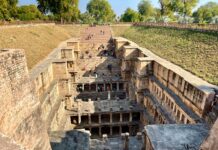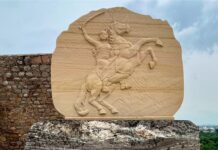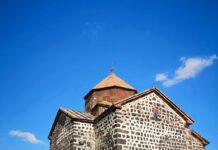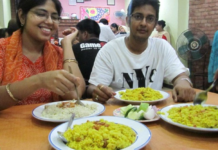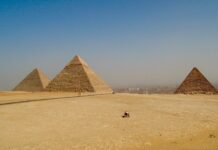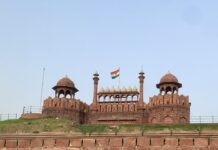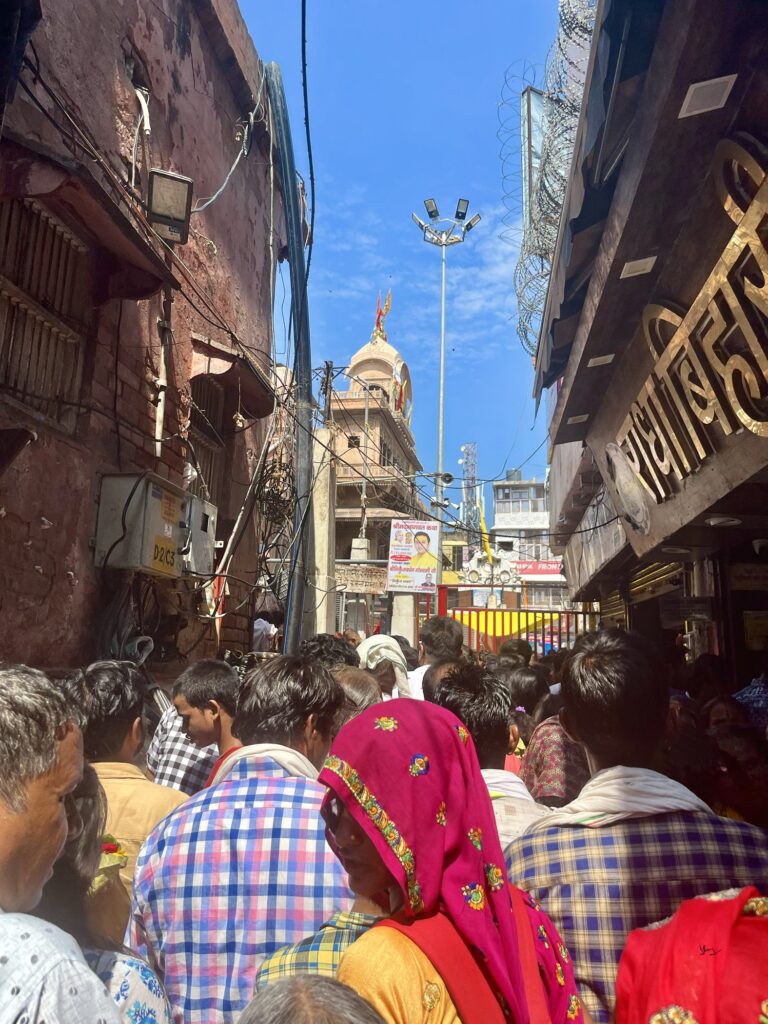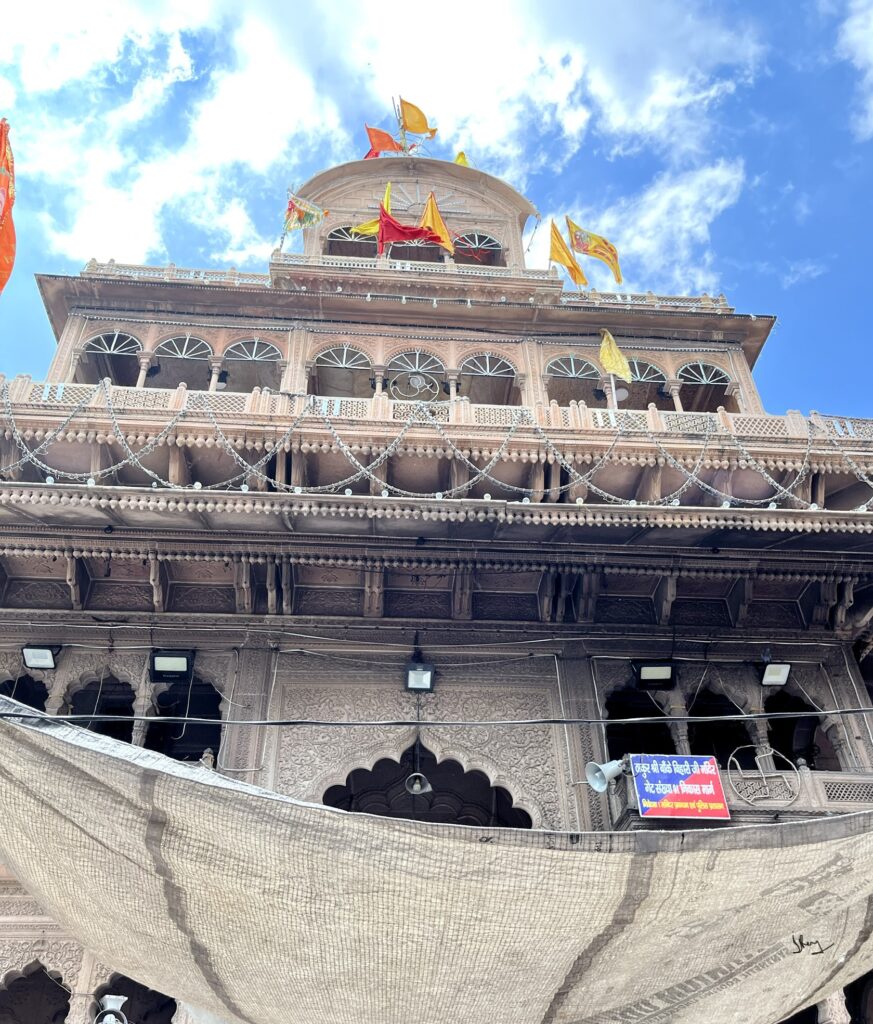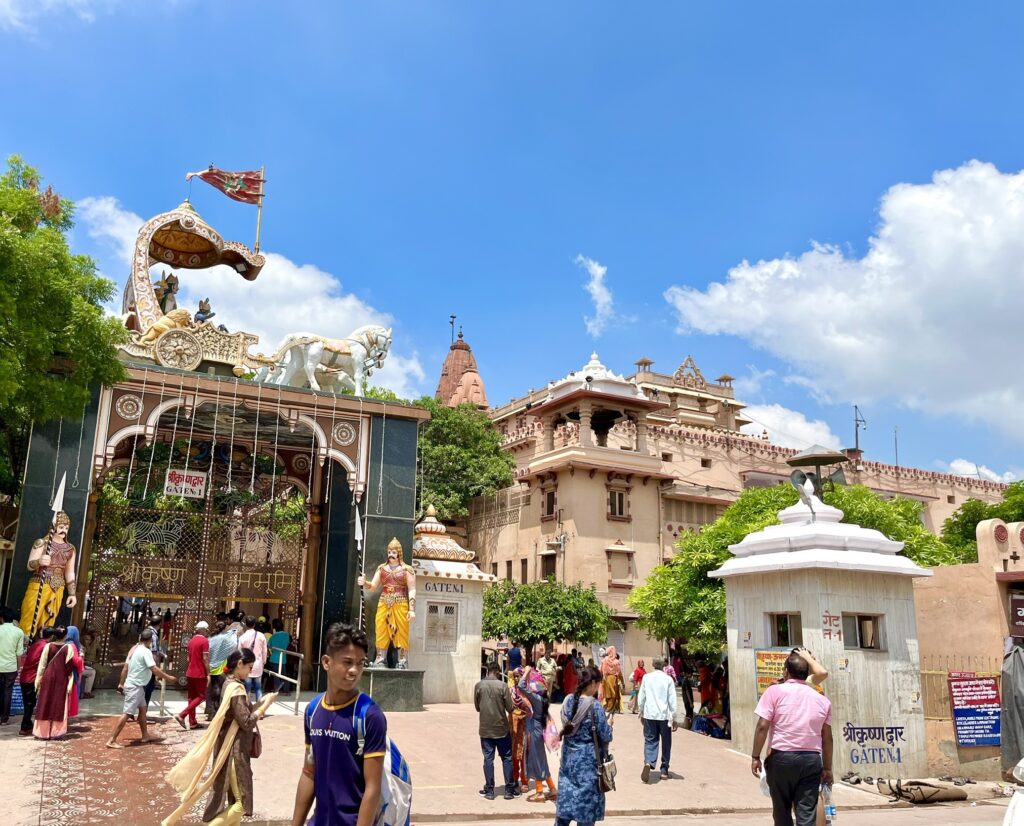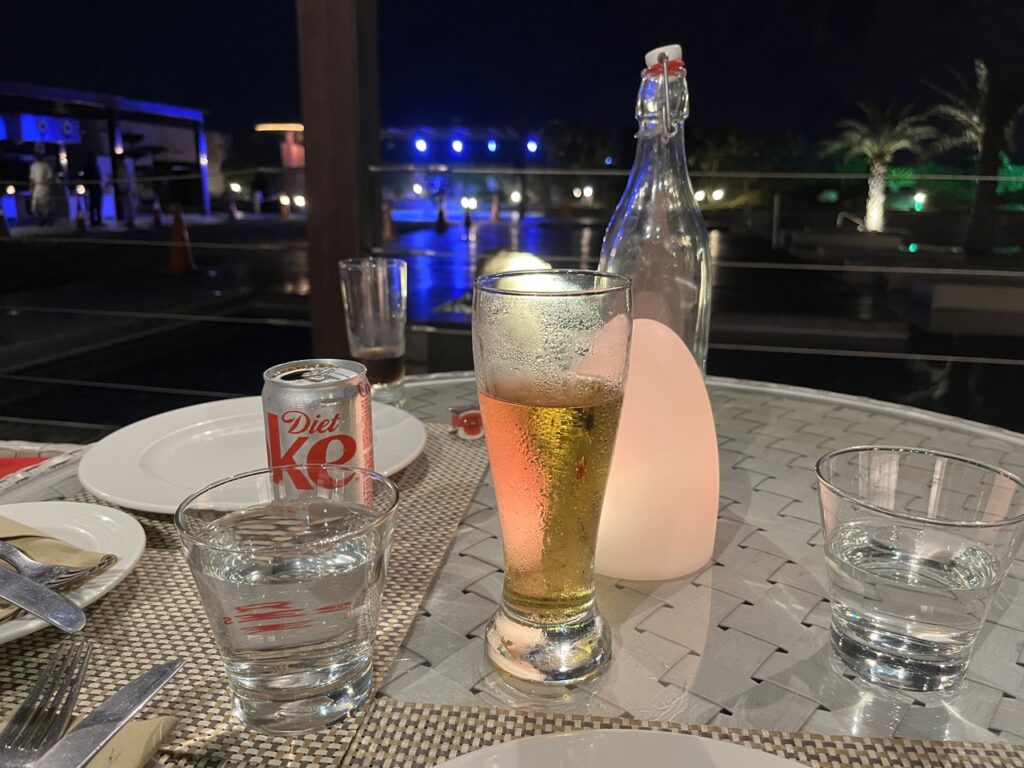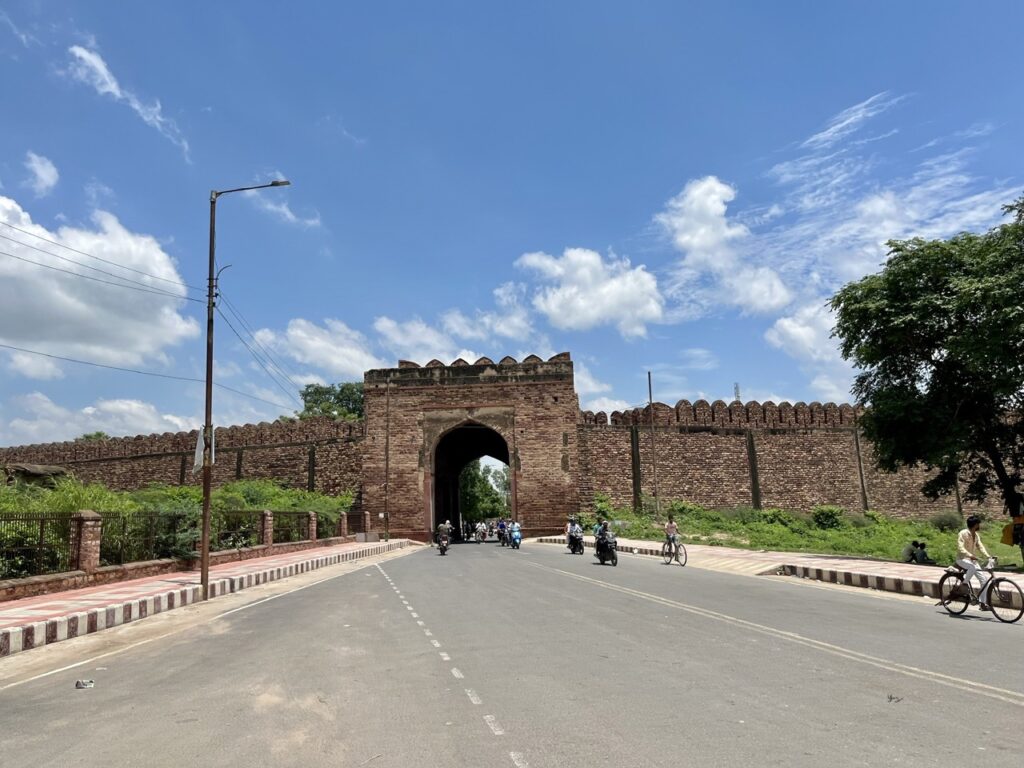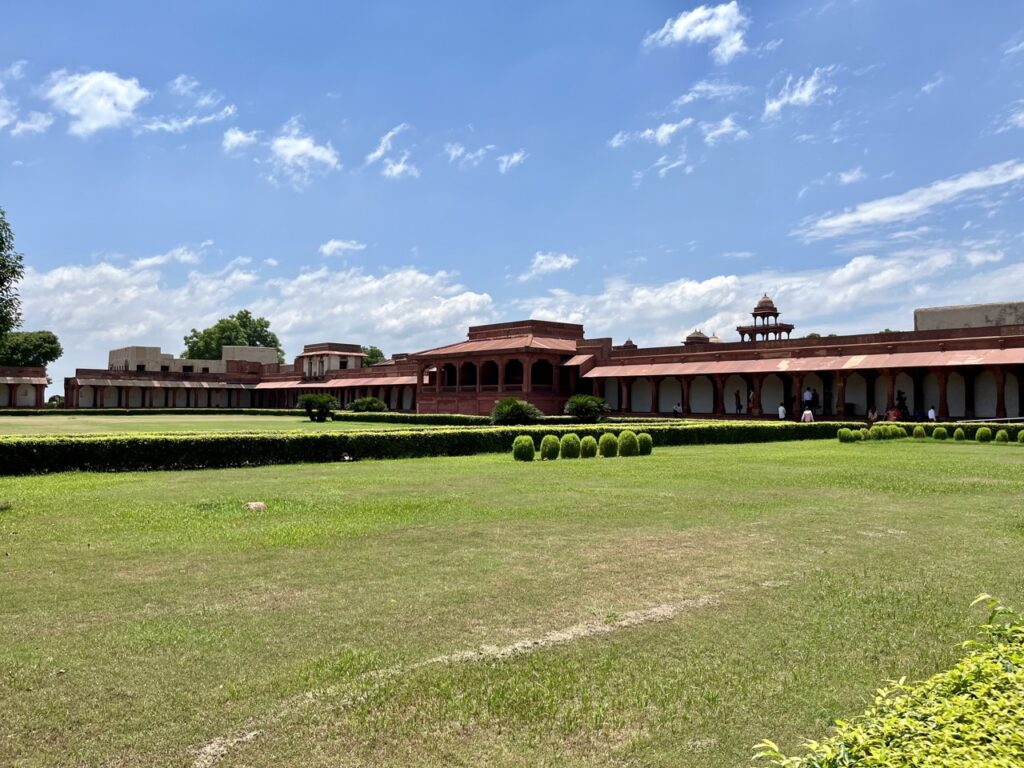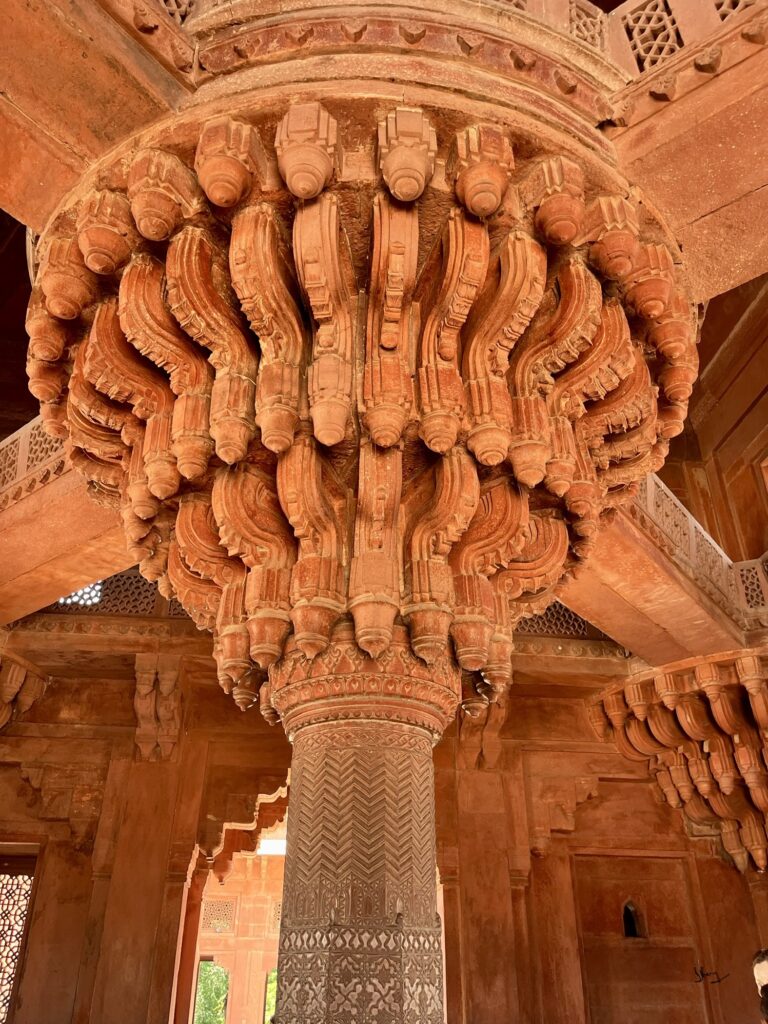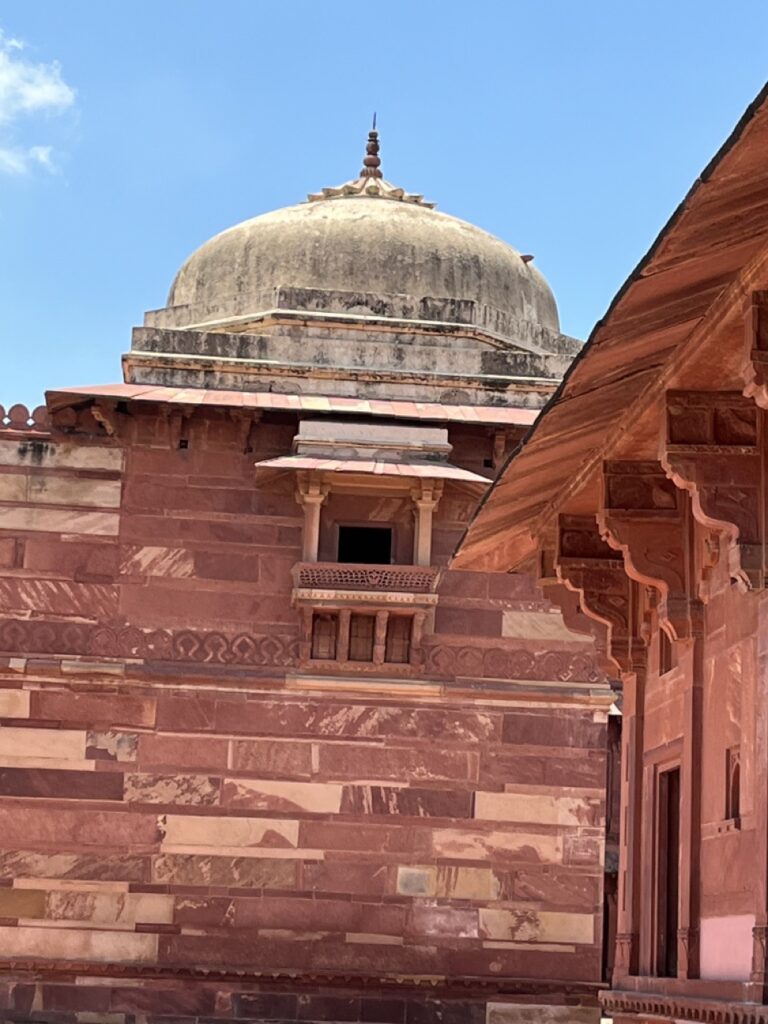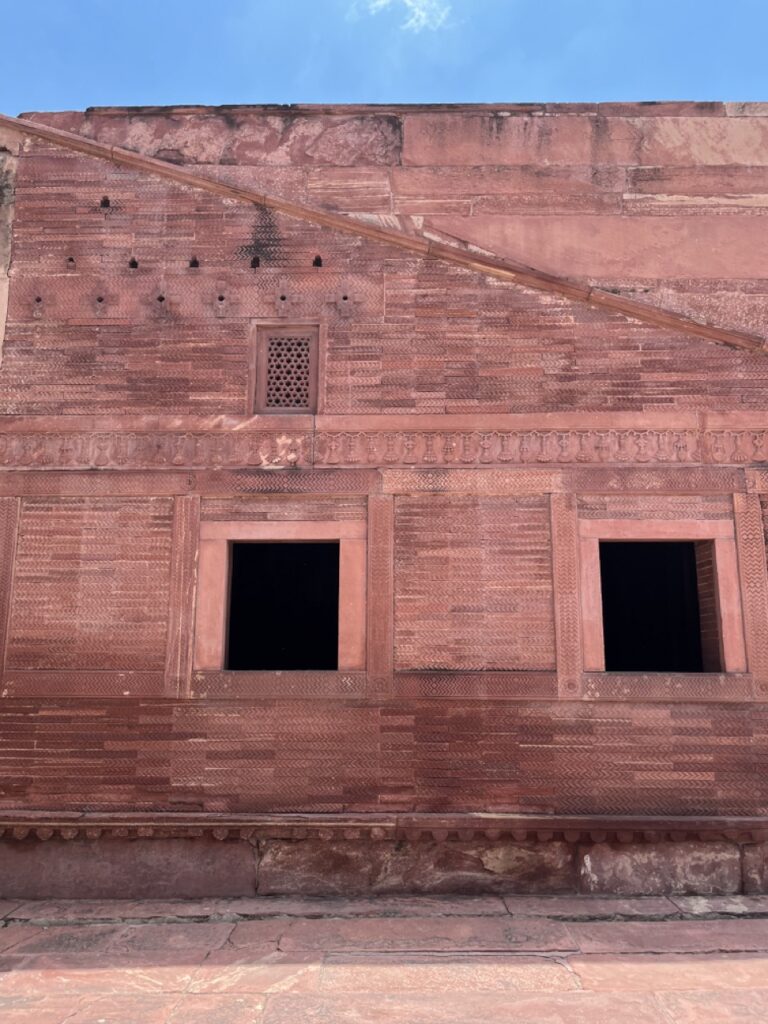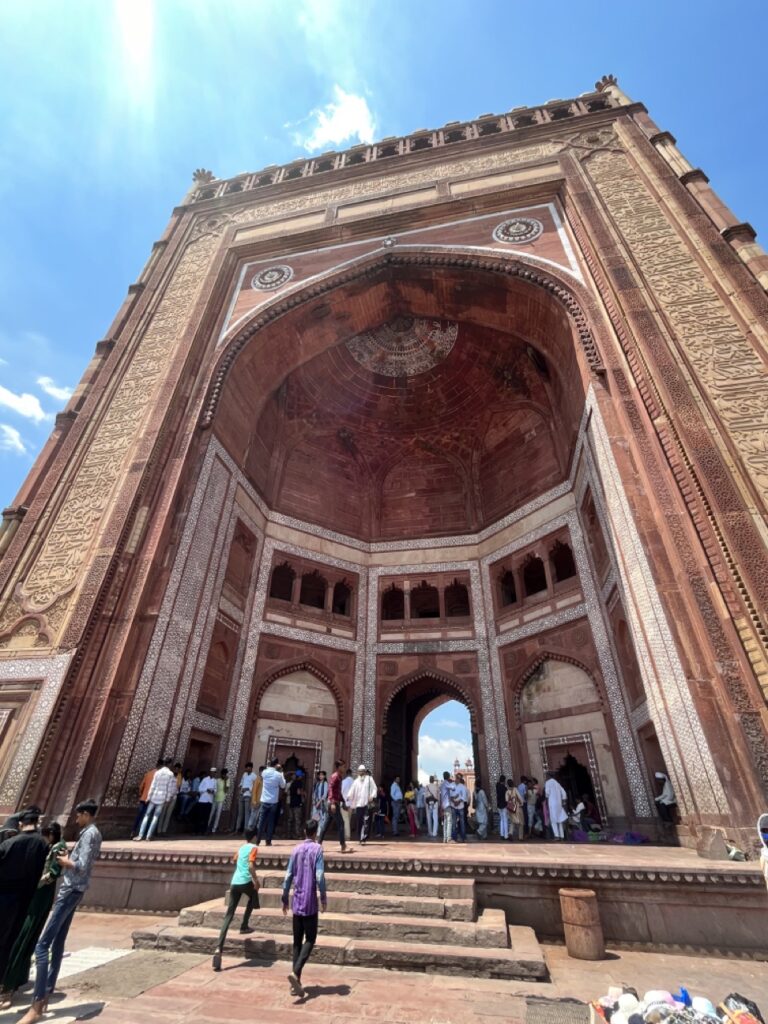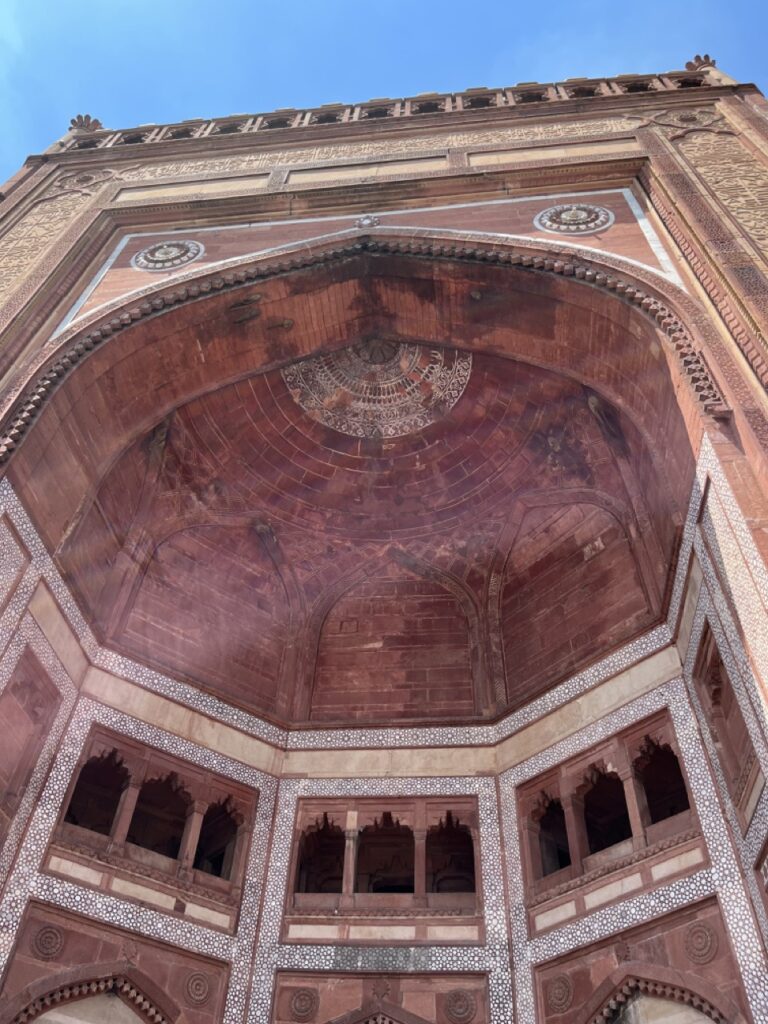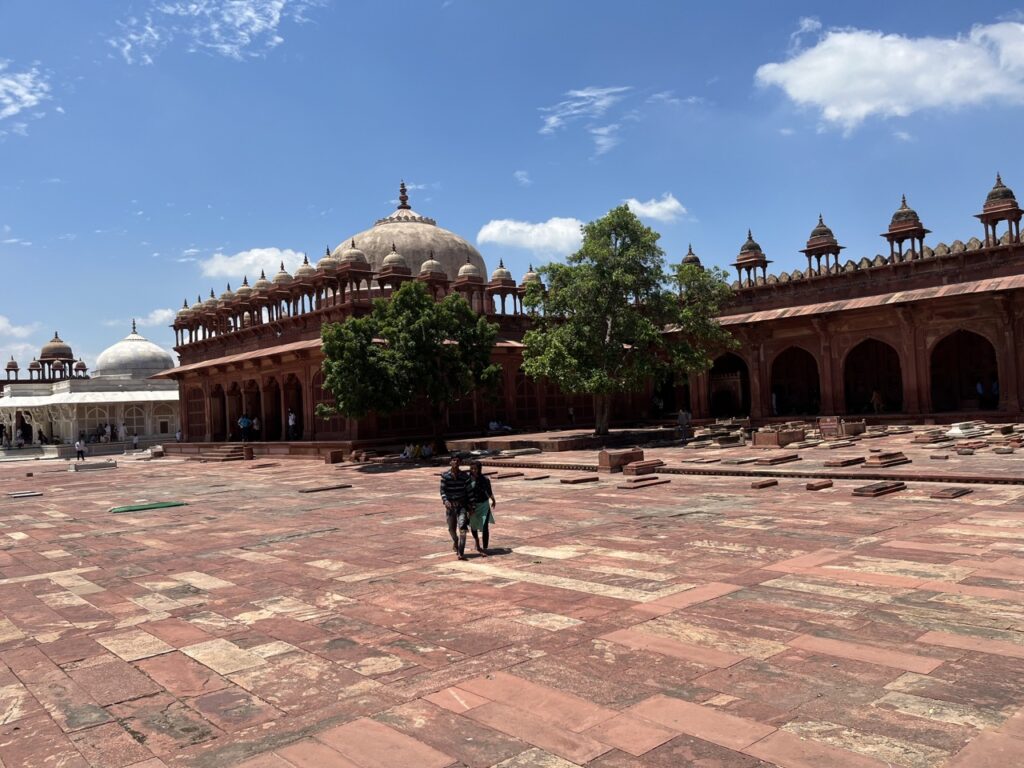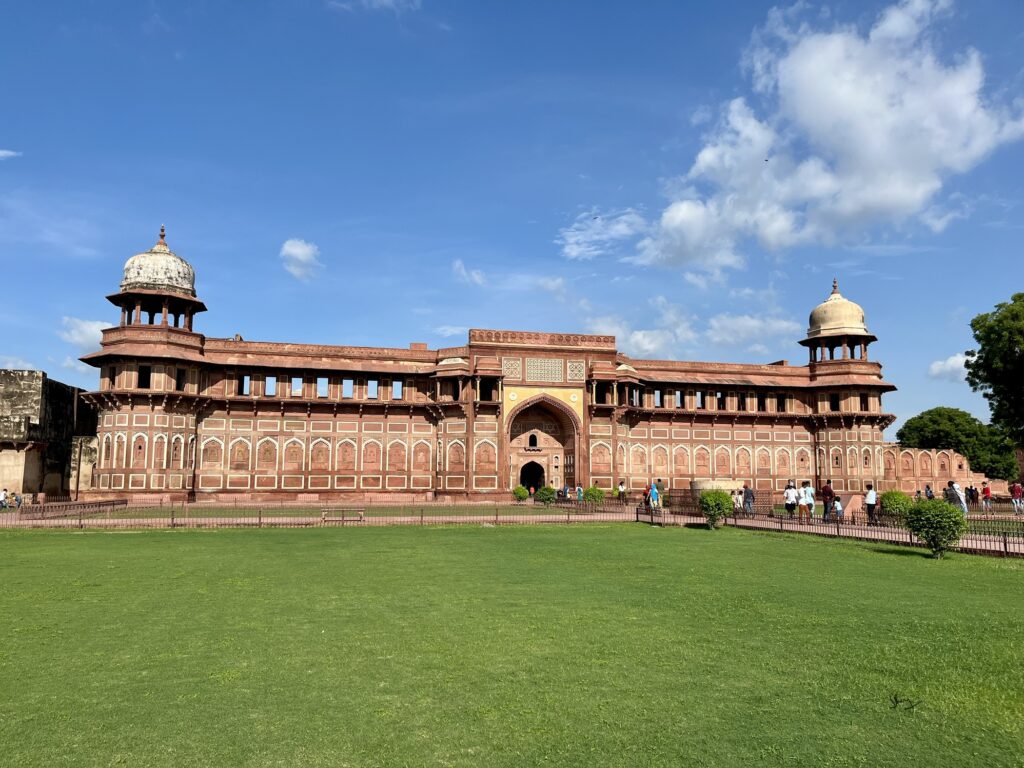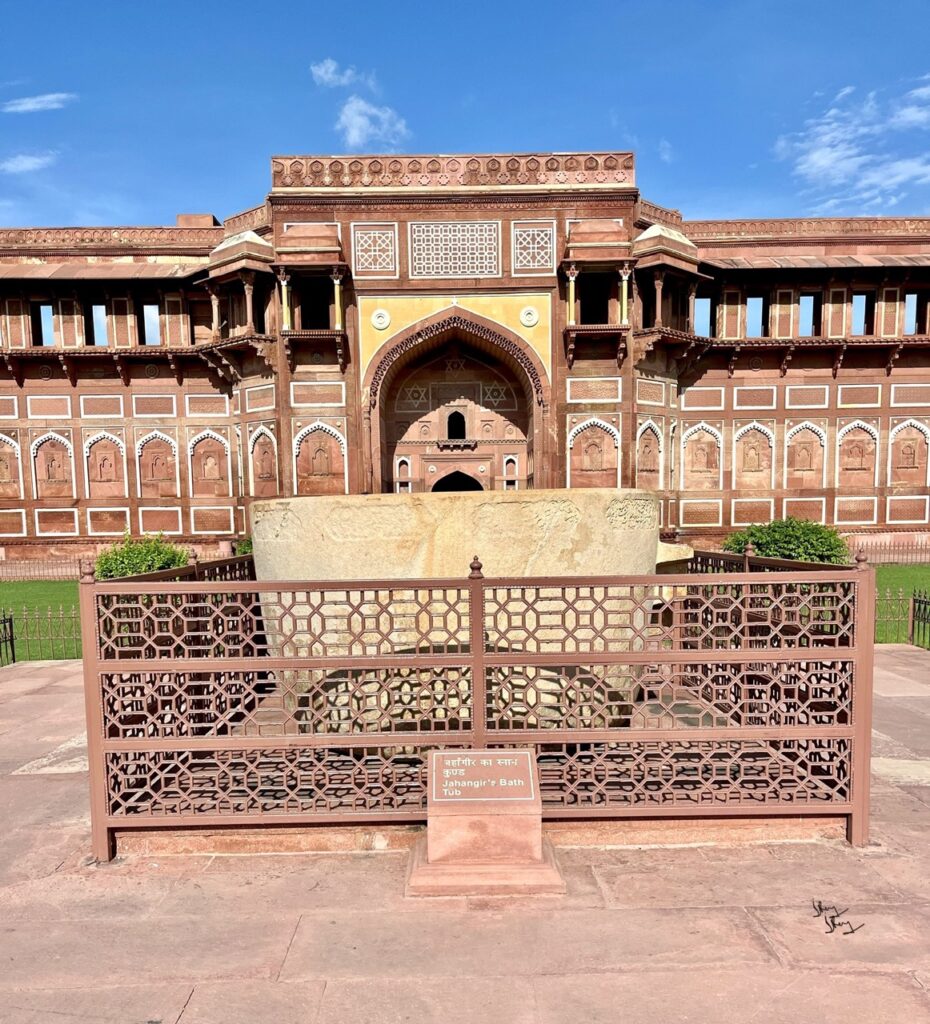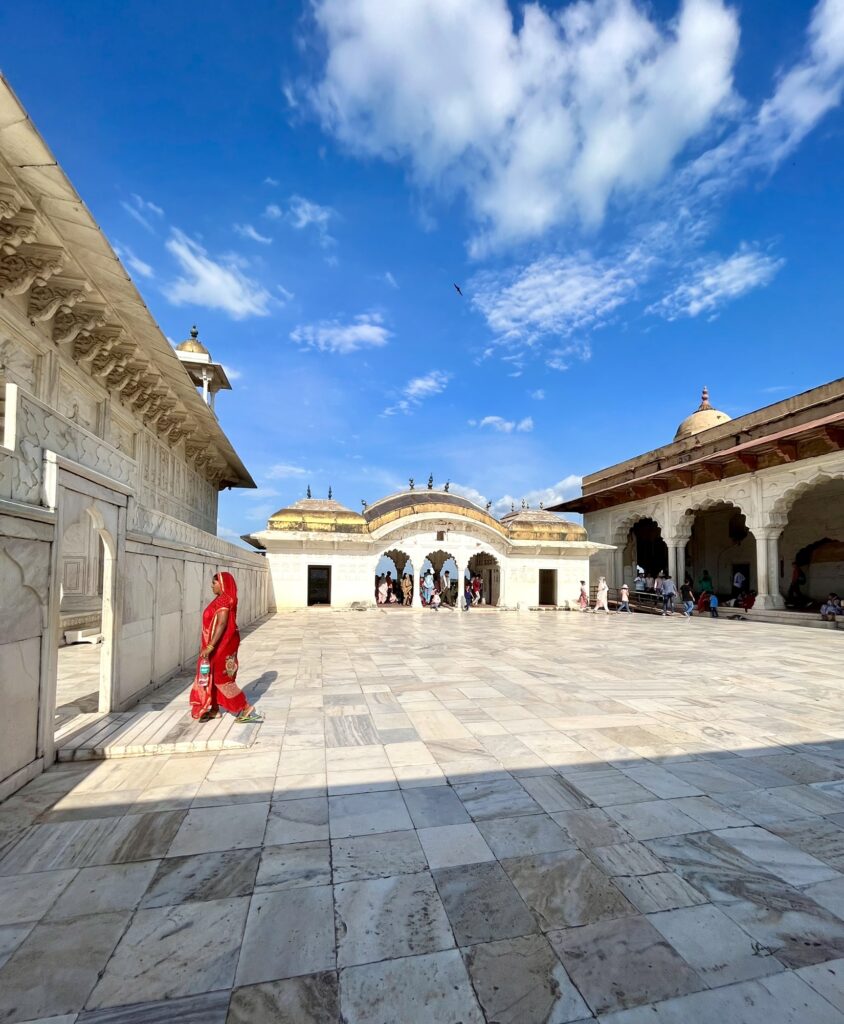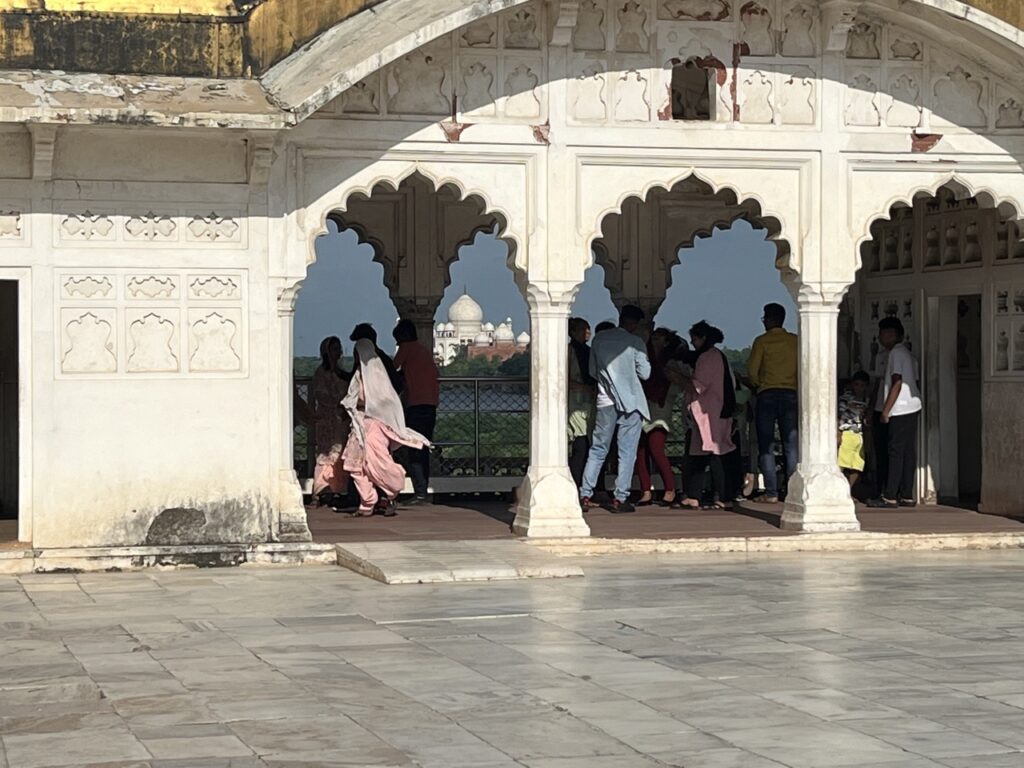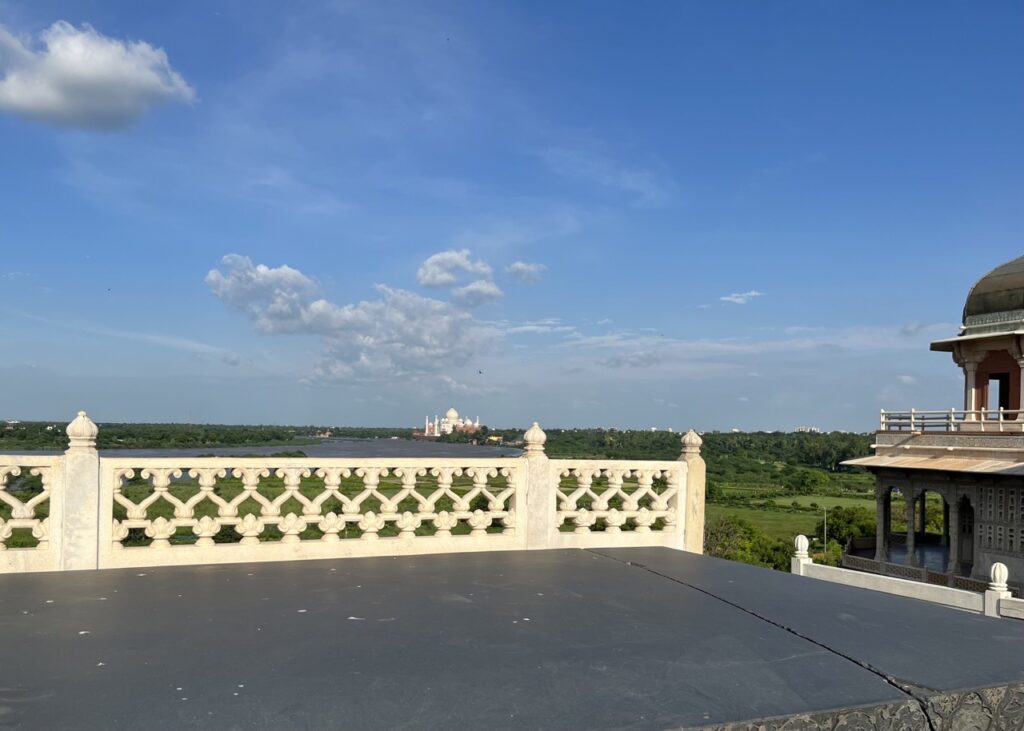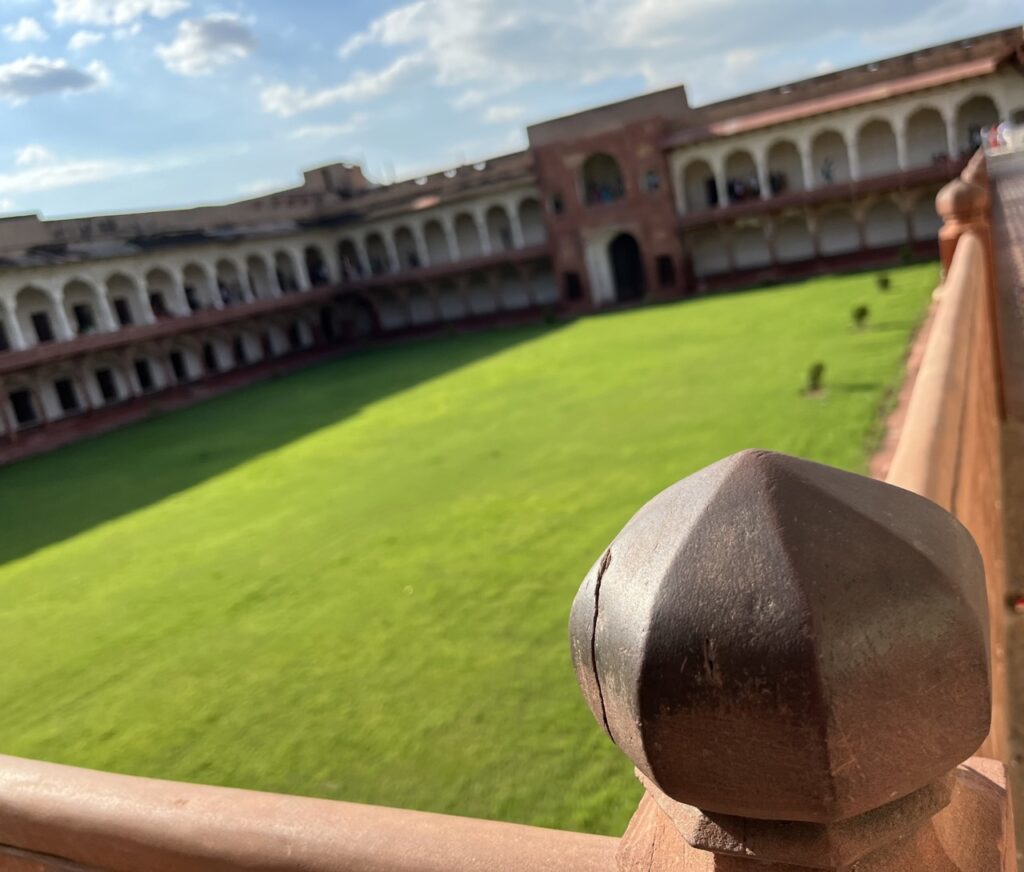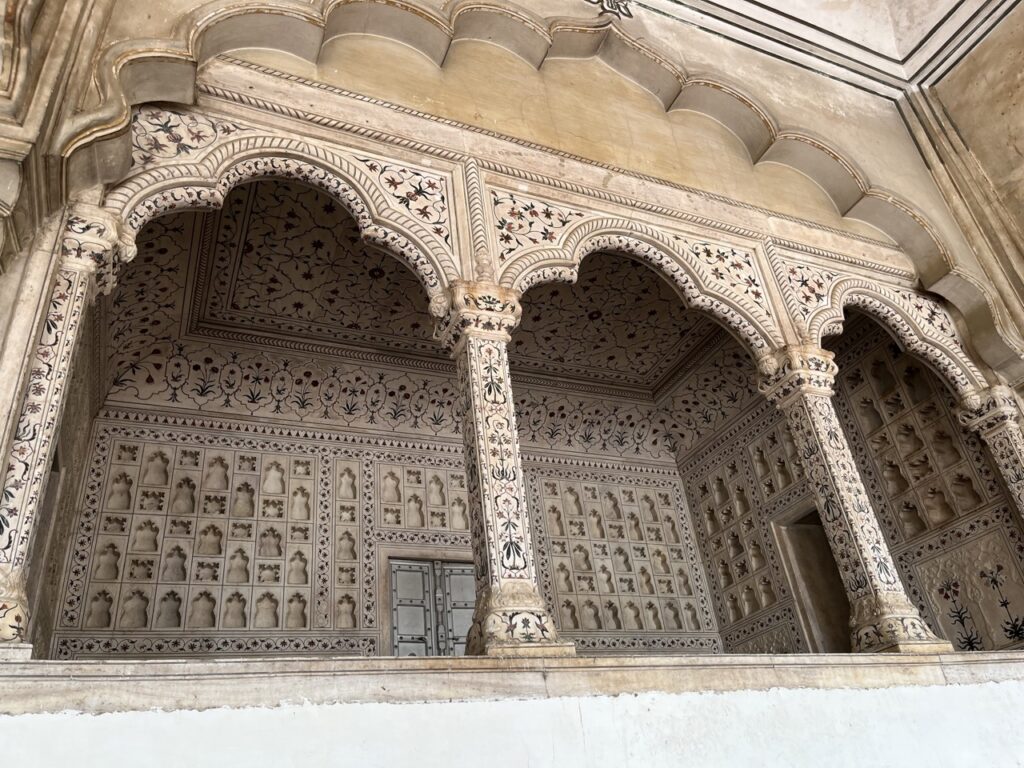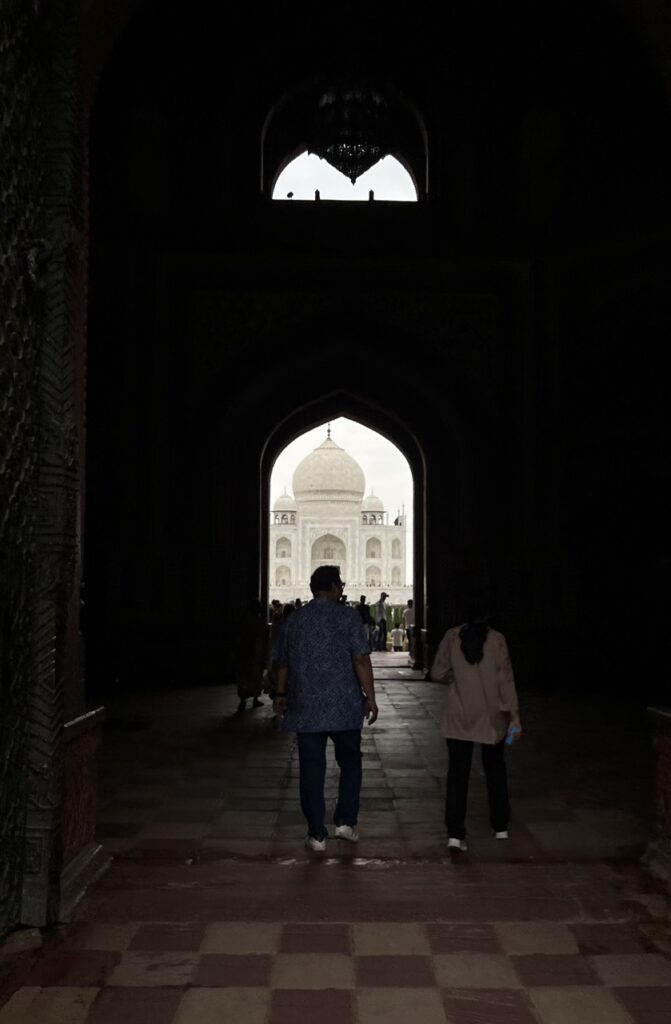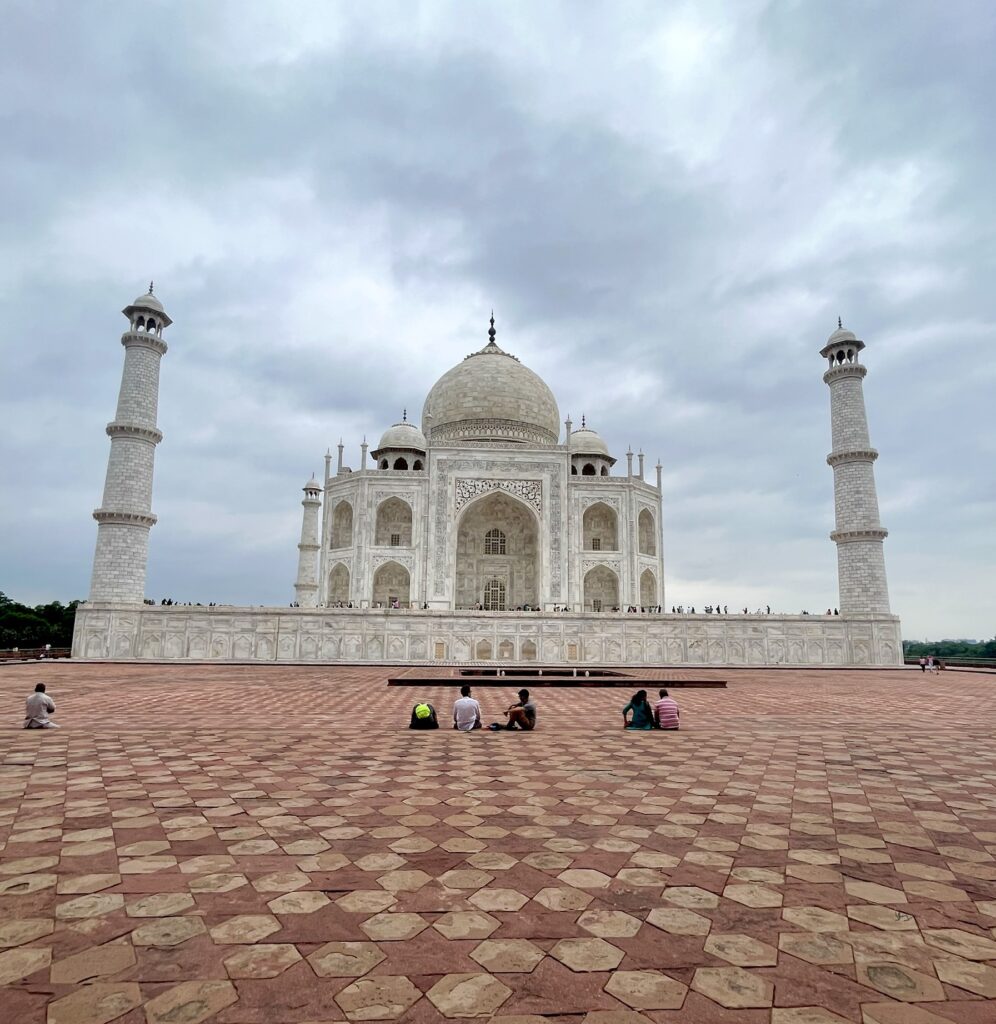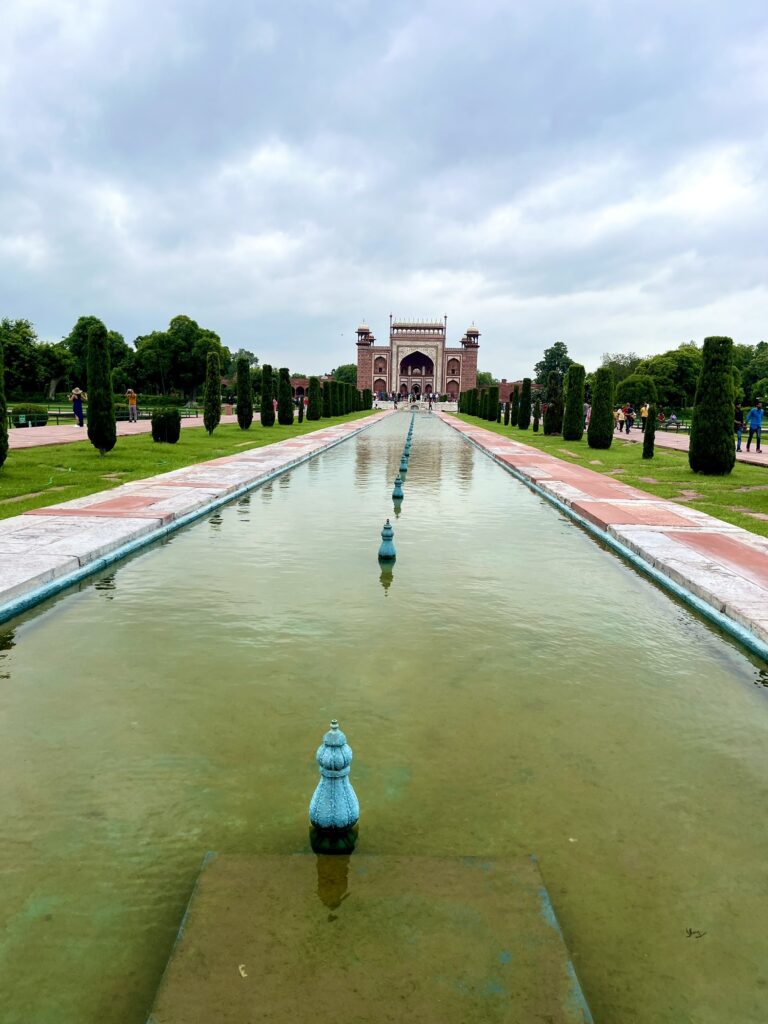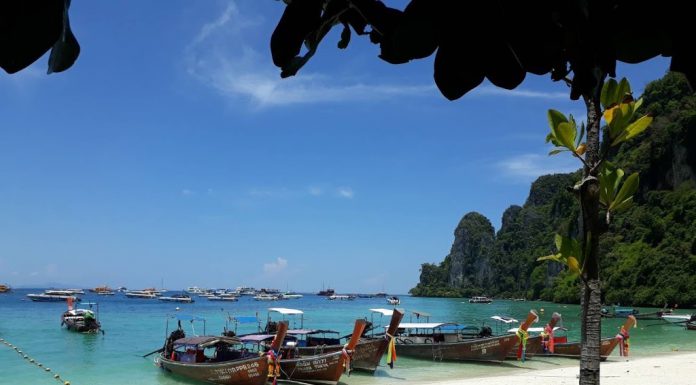Day-wise itinerary of my trip
- Day 1– Enjoy the drive on Delhi-Agra Yamuna Expressway. Stopover at Vrindavan, Mathura and Gokul before heading to Agra.
- Day 2– Drive to Fatehpur Sikhri and enjoy the old capital of Emperor Akbar before driving back to Agra. Have a sumptuous meal and then head to Agra fort. After the fort head back to the hotel and be ready for the blockbuster. The Taj Mahal in the moonlit night!
- Day 3- Early morning head to the Taj Mahal and then have breakfast before driving back to Delhi
Key facts about Vrindavan and Mathura
- Mathura is located on the banks of Yamuna where it is believed that Sri Krishna was born
- It was earlier known as Muttra during the Kushan dynasty in the 1st century AD. Later in the 2nd century, it was mainly inhabited by Buddhists and Jains
- Then notorious Mahamud of Ghazni attacked the city 4 times between 1500- 1575. His exploits of robbery and indiscriminate killing don’t need any introduction and thus the town was plundered and destroyed during his attacks
- Janmashtami ( the celebration of the birth of Lord Krishna) is celebrated with a lot of devouring and fanfare
- The other town Vrindavan has multiple temples dedicated to the Lord and has many interesting stories revolving around his childhood
- The entire area in the old scriptures was called Braj. However it was only realised by several 15th and 16th-century Bhakti saints, the most well-known of whom was Chaitanya Mahaprabhu. He became a devotee of Krishna and came to Braj on a pilgrimage to see the sites associated with his beloved Krishna in the year 1515
- Vrindavan is located about 125 Kms and Mathura is approximately 150 Kms from New Delhi
- Mathura is well connected by the Indian Railways, while Vrindavan does have a meter gauge line connecting Mathura but its not connected to any major cities in India
- The nearest airport is Agra about 65 Kms away. Once the Noida airport becomes operational probably this would be equidistance
Day 1
The drive from Delhi:
August is a great month to travel in and around India. This is the time of the year when the monsoon starts to dwindle and the occasional pitter-patter does not cause any constraint to travel. The effect of months of raindrops the tropical mercury, making the heat manageable and given the fact its considered off-season in the tourist circuit makes accommodation and travel well within the budget. For me personally, the year 2022 has been a year of first for me and the fact that my calendar was free in August provided me with an opportunity to set sail on the Indian highways
In recent times, the time for Delhi- Agra road travel has considerably reduced due to the construction of the magnificent Delhi- Agra Yamuna Expressway. The quality of the road is world-class and incomparable to any other road in India. Although, I would rate the Mumbai- Pune Expressway at par because the natural beauty of the Western Ghats clearly has the effects of Oxytocin on me
While driving from Delhi, the town of Vrindavan arrives before Mathura. I took the Vrindavan exit and drove for about 20 minutes through a meandering one-way road all the way to the Parking spot opposite the outstation bus stand. There are multiple entries to Vrindavan that I eventually learnt the hard way. Therefore, please tag your vehicle on Google maps or take a picture of the parking space for future reference. Else you will also learn it the hard way!
The Parking fee was ₹100/- and finding a shade for the vehicle required a lot of determination. Luckily, I found one, although it would not be a respite for long as the sun shifts Westward. Thankfully it was 10 AM and the midday sun was 2 hours away, and I thought I would be back within that timeline.
The distance from the Parking to the Banke Bihari temple was approximately 1.5 Kms, although it will feel like an eternity. I hopped into an electric auto rickshaw that was stationed outside the Parking spot and to my utter surprise, he demanded a princely sum of ₹50/- that was even below my expectations. This is probably the first tourist place in India ( sans Mumbai) where I did not haggle and bargain for an auto fare. With an air of accomplishment, there was a smile that was positioned on my lips that remained intact in spite of the harrowing traffic and exhilarative traffic sense of commuters
Let me assure you that holding on to the smile was not easy amidst the electric shock that was administered to me every few seconds! The incessant honking all around for absolutely no reason floated me to a state of vacuum as the grey matter of my brain froze due to the 3rd-degree torture. It was exactly at that time the divine intervention showed me the light and helped me discover the pattern!
Honking is just a simple mode of communication among drivers of all vehicles, with no discrimination of colour, caste, creed, religion and gender. There are just different notes and shrillness as per the style of communication. A tap 1-second honk means just a “Hello, I am there too, can you give me a little space”; while a non-stop long honk means, “Get the F*** off, are you out of your mind”?
The Spy Game
The auto driver dropped us about 300 metres from the temple and showed us the direction of navigation by pointing his fingers towards it. My friend who was accompanying me enquired if the remaining distance has to be traversed on feet to which the driver nodded in affirmation. Before I describe in detail this breathtaking 300 metres in details let me cut to the chase by declaring that tourists who adore spy thrillers and have read and watched at least 50 such Hollywood flicks will clearly have an advantage here!
The mission to see and greet Banke Bihari Ji has three levels each tougher than the previous! When I explained this to my friend she started giggling and I provided her due caution to understand the mission and be serious about it. She didn’t pay heed to my advice and fell prey to the consequences of it! On the other hand, you( my readers) have the opportunity to not repeat the mistake and read very carefully and understand the plan end to end.
The first level is all about being cautious of dangers from all sides. The enemy will send hundreds of 2-wheelers on a pedestrian-only path who will appear and disappear in tandem in between an ocean of crowd. Try and recollect the film “: Hard Target” and act like Jean Claude Van Damme who showed excellent skills of playing hide and seek, and vitality to emerge victorious. That is exactly what is expected of you and it’s very simple. This level clearly prepared me for Level 2 where the prerequisite is to keep the eyes open at all times across any angle, and if possible to invent new skills to see from the back of the head!
In level 1 my friend was smart enough to just follow in my footsteps and thus remained unscathed. As we reach the next alley about 50 metres from the drop point I realised we are now activated for Level 2. Immediately, I turned around to explain to my friend that it is critical that we work as a team to keep ourselves from harm’s way that can jeopardise our mission. I decided it was time to use my good power of communication to make her understand what I meant by having an eye at the back of the head!
I said that we need to face each opposite to each other and traverse cautiously toward our destination. Thus I volunteered to walk forward while she face opposite me and walk backwards. She waved her hand with amusement on her face and dismissed my suggestion and started walking forward with a complete air of casualness. That’s when the Thunderstruck!
While I understood that she made a serious mistake ignoring the warnings and underestimating the enemy agent. Later she told me that she thought I was just exaggerating facts to provide dramatic effect and be humourous. I can only hope that my readers won’t do the same mistake and assume I am taking creative freedom to explain the situation!
Just as she has taken 2 steps forward the enemy agent that possessed 4 agile legs and a tail for skilful manoeuvrability flicked her sunglass in the blink of an eye. With one of our main weapons gone, I had no other option but to raise the ante of the game. My hours of dedicatedly reading tales of espionage had trained and prepared my mind tailor-made for a situation like this.
The enemy agent did not go out of my sight and was sitting on the sunshade of a neighbouring building with a few sunglasses, and hats in front of him. Immediately, I knew that it was a sign from him that he can be turned with the right amount of motivation and help from the locals. The question is how do we quantify motivation? I decided to stick to the basic need of evolution, i.e. food and all of us are aware that our four-legged ancestors have a weakness for bananas!
I bought a dozen of bananas and an orange as a contingency plan. The movement I offered the bananas our double agent twirled his tail and jumped down and handed over the sunglass to my friend. Then he turned around me and looked at me with a rebuke on his face. Without thinking twice I brought out the orange from my trouser and made the peace offering so that he allows us to move to the 3rd level of our mission
The final round is not only about adrenaline-pumping stunts but also utilising the grey matter to a large extent to complete the mission. The decision has to be taken impromptu without a second thought and one should not fear dirtying their hand; in this case the leg. The final 100 metres to the temple was through a narrow lane amidst a sea of crowds. For the first few seconds, I struggled to concentrate as the fear of Covid 19 was clouding my judgement. I was wearing my mask and I calmed my mind as this was the best-case scenario at this time to keep the mission alive
Thankfully, my friend acted with a lot of due diligence too after the episodes couple of minutes back. Still, being a senior agent I observed that she is rolling her eyeballs too much towards the sky as if to overcompensate for the past incident. I intervened and requested her to keep an eye on the road as well, as my nose was picking some dangerous scent ahead.
The scent of danger was foul-smelling and thus I stopped to get a long look at what I am going to land my feet on. With the devotees pushing through it was not possible to stop by and I was forced to dance to the music. Soon I realised there were multiple alleys connecting this lane like the great tributaries of the Ganges!
The tributaries were neither snow nor rain-fed and I didn’t have the time to find its source. I just wanted to run the last 20 metres to the temple door as the foul smell made me nauseated. Unfortunately, I couldn’t run as I feared that I will lose my slippers amidst the torrent of water. I knew something was amiss as till now except for the fear of getting infected by leptospirosis, there has not been any perceived grave danger on our way.
I am sure my readers have heard about Honey traps, but have you heard that it can be attempted by the same gender? A gentleman approached me stating that he noticed that I am struggling and he can surely help me inside the temple through a shortcut. I was actually tempted of giving in to this request but at the spur of the moment, my fellow agent cautioned me that this can be a scam as the distance left is merely 20 metres away.
Finally wading through water and dirt I reached the step of the temple where the slippers had to be deposited. A small kid was standing beside the steps and offering to keep the shoes safe if I agree to pay a small token in return. Mentally I didn’t care about the slippers and was prepared to chop off my leg and forget the slippers. My instincts warned me against taking a chance but I was getting tired due to the mission and acted against my gut and handed over the slippers. A few steps inside the temple I realised there is a small store for devotees to keep their slippers. This store is managed by the temple authority, but there was no going back now against the tide of devotees so I kept moving forward and completed my mission successfully!
Banke Bihari temple
The most fascinating part of Banke Bihari is that it is believed to be the combined part of Radha and Krishna. Bankey Bihari was originally worshipped at Nidhivan, Vrindavan. Later, when the Bankey Bihari temple was constructed around 1864, the idol of Bankey Bihari was moved to the new temple.
I started taking baby steps towards the temple sanctum with thousands of devotees around me chanting and moving mesmerised towards the idol. Krishna is the 8th incarnation of Vishnu and is known to create his own Leela that is known only to him. It dawned on me that I was at his feet on my birthday in spite of being an atheist and that can only be his Leela. I was tested at every step, and despite that, I landed at the source of this powerful energy that one can feel inside the temple premises.
I looked up and could see the idol quite far away. As I started moving, I suddenly saw a volunteer pull a curtain before the idol and then moved it back after a few seconds. A devotee beside me on my enquiry explained that the eyes of Shri Bankey Bihari will make one unconscious if seen for a long time. Thus the curtains are drawn to disrupt the gaze and safeguard the pilgrims. He also enlightened me that this is the only temple where loud temple bells are not used to wake Krishna in the morning. The Lord was a child here and a child is never woken up in a startle. This is probably the only temple wherein Aarti is not done as it might disturb Him.
The Lord here does not get up until 9 am, as it is believed that Bankey Bihariji has been up until late at night sporting. Mangala-arati is conducted once a year on Janmasthami. Only one day a year the lotus feet of the Deity be seen, on Akshaya Tritiya, on the third day of the bright half of the month of Vaishaka (April–May). The autumn full moon day is the only day that the deity holds a flute, and also on this day, he wears a special crown. Shri Bankey Bihari comes off his altar and can be seen in full view on the last five days of the month of Phalguna, during the Holi festival. He can be seen with four gopis, who are seen just at this time.
Once inside the holy sanctum, the chaos all around seems to disappear and a sense of tranquillity prevails, inspite of fighting for space to catch a glimpse of the deity. My heart wanted to stay back for some more time but common sense prevailed and I started to walk towards the exit. Soon, I was out of the temple on the other side and now had to find the route back to the entrance.
To my utter dismay, I could not find a single shop to buy slippers and the sheer thought of walking bare feet to the entrance made me cringe. But who can fight the wishes of the Lord that’s when I smiled and started following the herd back to the temple entrance. The boy was dutifully policing all the shoes under his custody. I picked mine and tipped ₹ 10/- that brought out such a beautiful smile gleefully displaying his front teeth immediately. I will not forget that innocent smile ever!
The Brunch
This time around I did not wear the slippers and walked bare feet all the way back to the auto stand, wherein I washed my hands and legs and wore my footwear. It was now almost 12 and we were famished. Vrindavan is famous for Kachori and Lassi for breakfast. I followed suit and ordered a plate of Kachori that was provided with a generous dool of butter on the sabzi( Potato- gravy). Food is a great connector and while eating I started a conversation with the shopkeeper who enlightened me about a legend that is popular in the streets of Vrindavan
This incident supposedly happened in the 1920s when the Lord himself came out of the sanctum. Before I narrate the incident it would be imperative that I remind you once again that the Lord is worshipped as a small boy in this temple. A small kid has to be fed and it is the responsibility of the parents to ensure the right amount of nutritious food is provided to ensure the overall mental and physical development of the child. Keeping this in mind the Lord is offered 6 meals a day!
I was quite intrigued and enquired about the special menu for the Lord. The shopkeeper grinned at my curiosity and said in the morning breakfast at the time of awakening consists of fruits, little snacks and a drink offered to the Lord. After the morning rituals and before the opening of the temple for darshan, the Lord is offered a sumptuous meal called Balbhogis offered that comprises Makhan mishri and a variety of sweets and namkeens
This follows the Rajbhog the main meal, that consists of menu Roti, a variety of dals and vegetables, curd, Raita, Karhi, Rice, Kheer, Doodhbhat, Adhota milk, Papar, Chutney, Pickles and other sweets and assorted items. In the afternoon the Lord takes a nap and at this point, afternoon snacks are offered before the Lord takes a rest.
In the evening fruits and seasonal drinks are offered at the time of awakening. The menu for the evening meal is called Shayanbhog, which consists of puris, stuffed puris, kachoris, seasonal vegetables, curd, raita, assorted sweets and namkeens.
Parents with a small child will agree with me appetite of children can be quite erratic. Personally, I have found my daughter waking up in the middle of the night and claiming to be hungry. Thus we used to keep ice creams and various snacks in our refrigerators. Probably, something like this happened one night at Banke Bihari temple.
One of the local sweet shops near the temple had a very tall order for the next day. By late evening the owner of the shop realised a bit of work was still pending. In those days there were no electricity and transportation late in the evening was almost insignificant. Thus the shopkeeper sent his staff home and decided to stay back at his shop and finish the remaining part of the work.
As the shopkeeper was engrossed making the last few Laddos, a charming boy, about 9-10 years of age appeared out of nowhere and asked for some food. The shopkeeper was a bit concerned to find a child so late in the evening and his eyes looked around to identify his parents. He couldn’t ponder much as the mesmerising voice had a trance-like effect on him. He quickly got up and put 4 Laddos in a Leaf and handed them over to the boy.
The boy in return handed over a small gold bangle for the food and disappeared before the shopkeeper can refuse it. He kept the bangle in his cash box and decided to investigate the matter the next day. In the next morning as per his daily custom, he went to pay his obeisance in the temple and found a lot of commotion inside the temple premises. On enquiring, he learnt that a gold bangle was lost from the jewellery box of the Lord and he was speechless recollecting the incident of the previous night. He requested the head priest to leave everything and come with him to his shop.
When he brought out the bangle from his cash box there was pin drop silence. The priest and the staff were completely astonished and enquired how it landed in his cash box. When the shopkeeper explained the whole incident, the cops believed him and the temple staff did not press any charges stating that the Lord has its own ways and should be respected as nothing is lost after all.
It is believed that the Priest kept the Shayanbhog before the Lord but forgot to offer it. Therefore the Lord did not eat and was hungry and was forced to go out of the temple in the middle of the night. After this incident it has now become a custom that the Lord is offered 4 Laddos along with water and a beetle leaf is left on a table before the temple is closed.
As per the legends Banke Bihari Ji visited the famous sweet shop “Brijwasi” and after that, it prospered by leaps and bound. I am not aware of the authenticty of this, although I can vouch that this does help the business of Brijwasi stores. Mostly all pilgrims in Vrindavan make it a point to visit Brijwasi and eat something as the Lord picked up this shop to eat.
Tryst with Gokul
Returning back to the Parking place was nothing less than an expedition in itself. I was careless and did not click a picture of the place nor took note of the name of the area. Thus, when I tried to get transport back to the parking I had to face a bit of rebuke as I did not know my destination. I guess some of the Auto rickshaw drivers thought I was generally pulling their legs and had no intention to travel.
Thankfully, I did manage to find a kind rickshaw driver who heard me patiently and decided to drop me there. Well, I have a terrific sense of observation and art of communication that I managed to salvage the situation but if you have doubt yourself about these qualities please do take note of the exact location as mentioned by me earlier!
On getting into my vehicle I directed my GPS to the Janmabhoomi temple at Mathura which was just a 20 mins drive. The Lord’s Leela had a different plan and I chanced upon meeting a gentleman called Akash Sharma who is a devotional singer by profession and a tour guide by choice. Actually, I met him steps away from the Janmabhoomi temple and at his request, I decided to visit Gokul before visiting the Mathura.
Gokul is about 15 Kms from Mathura and takes about 25-30 minutes. It is recommended to visit the Mathura temple before visiting Gokul if the next stoppage is Agra. Thus, it was a bit of an inconvenience but Akash tempted me by offering to sing a few kirtans en route to keep me entertained. Now that is something I couldn’t have missed out on under any circumstances as I love music in any form.
This town has significant importance for pilgrims as Shri Krishna spent his childhood here and slowly the world realised that he is no mortal being. Akash told me that he would like to narrate the incident of the birth of the Lord to me as this will help us spend our driving time effectively. Though I have heard this innumerable times I did not resist as he was an eloquent speaker and in between sang to narrate the stories
For the benefit of my readers, I am narrating the incident as spoken by Akash, except for the rhymes and the song that was a pleasure for my ears only. The parents of Shri Krishna Devaki ( mother) and Vasudeva ( father) were imprisoned by Kansa, the brother of Devki owing to a Godly spell that the 8th child of Devaki will ultimately kill Kansa. This paranoia lead Kansa to kill the first 6 children of the couple inside the prison cell, however, things changed after that.
The 7th child was called Balarama the elder brother of Shri Krishna and was thought to be the incarnation of Lord Vishnu himself. When Devaki conceived Balarama, Kansa could sense the potency of the child and be fearful that the prophecy was basically to trick him and actually the 7th child might lead to his death. What happened next is beyond the realm of modern science! Nevertheless, in modern times we are aware of surrogacy and who knows how advanced the old civilisation was?
It is believed that Vishnu intervened and when Balarama was conceived, his embryo was transferred from Devaki’s womb into the womb of Rohini, Vasudeva’s first wife. In Mathura however, everyone thought that the foetus had aborted i.e a miscarriage had occurred.
Similarly, when it was time for the Lord to be conceived by Devaki the to be foster mother Yashoda, also conceived. When the 8th child was finally born inside the prison the miracle of the Lord was at play again. The heavily guarded prison doors opened up with no sight of the guards. Vasudev easily walked past the prison straight into the river Yamuna which lowered its water level to allow him to wade in the water.
Vasudev held the baby above his head as he walked towards Gokul through the waters of the Yamuna. It is also believed that a thousand-headed serpent rose out of the water and covered the head of the child to protect the incarnation of the Lord from the heavy downpour. On reaching the house of Nanda he handed over the baby to Nanda and exchanged their daughter(Yogamaya) whom Yashoda had given birth to earlier. Vasudev exchanged the child and brought it back to the prison through the same route.
Once the girl child was inside the prison cell everyone woke up from their trance and the news of childbirth spread like wildfire. Kansa immediately rushed to the prison to kill the child and put to rest any chance of the prophecy being fulfilled. On finding a girl child Kansa was confused as it was not predicted in the prophecy. However, he didn’t want to take any chance because he thought this might be done to trick him. He decided to smash the child on the walls of the prison when the girl child flew out of his hand and turned into the goddess Durga. She laughed and rebuked Kansa and informed him that the Lord is already born and his time is coming to an end!
Gokul Temple
The last 100 metres to the temple have to be traversed on feet. For some unknown reason, Akash introduced us to his friend who is supposedly more knowledgeable and would take us inside the temple. I was slightly taken aback to learn that outsourcing happens even in this line of work! Therefore, I had to bluntly enquire about his value add for expecting a fee. It was clear to me that I am not hiring a guide for navigation as I believe Google Maps would have done just fine!
The new guide, who did not even reveal his name requested not to lose my cool because everyone at Bal Gopal’s door should come happily. I was not convinced by this logic but let it pass for the time being. I started smelling a scam and reminded myself to be a bit careful. Besides the temple gate, a small Go Shala( cowshed) is built to demonstrate to devotees how it used to be in the past. Shri Krishna was extremely fond of homemade butter made from Cow milk and this is an offering made to the Lord. When I enquired where is the actual Goshala of Yashoda, the question was avoided by vaguely replying, “far away”!
The temple is quite small and lacked pomp and grandeur compared to the ones in Vrindavan or Mathura. However, I loved the fact that the FIFO process is followed for the Darshan. Each group of devotees sit together with their guide and wait for their turn to meet and greet the Lord. During the waiting period, the guide warms up the pilgrims to donate to the temple trust that supposedly takes care of livestock and hermits staying there.
In between the childhood stories of Shri Krishna killing Putana, showing his mother the Earth in his mouth, and picking up Gandhamadan Parbat this noble cause of donation is brought up time and again as if it is the duty of the pilgrims. My guide actually reminded me of the “Wolf of Wall Street” movie. His sales pitches were innovative and very connected to reality. He said that in modern times tourists spend at least ₹ 2500/- in hotel accommodation. Thus one should at least donate a day’s hotel stay in the name of the Lord! I took a bow to this logic and he felt that he nailed the deal!
In between his amazing sales pitch he reminded us that in the Lord’s temple we should always smile and even donate happily to fulfil our wishes. It was pretty humourous that we had to demonstrate our happiness by looking up to the sky, raising our hands and Laughing “Ha Ha” at the periodic interval.
The entire scene transported me to the parks of Indian metro cities where morning laughing classes are conducted mostly for the aged. My mind drifted from one unknown face to the other and declined to return back to the temple. Suddenly, my friend knocked hard on my head bringing me back to the door steps of Gokul.
It was now our turn to see the Bal Gopal up close and personal. The small idol of the Lord is placed in a small palanquin and the priest re-iterates the story of the Bal Gopal. Slowly the priest enlightens the various packages of donations starting from ₹1300 and going upwards. At this point quite strategically an iron chain attached to the palanquin is handed over in the hand of the pilgrims and asked to sway the Lord to make him happy. For a devotee, it is an ultimate challenge to decline the donation while swaying the Lord! Therefore most pilgrims end up donating out of the sheer pressure being built in this process and of religious fear of displeasing the Lord.
When I posed the same question I politely declined to donate and observed the facial expression of my guide change to the grief of losing a prospective sales. The chain was also pulled away instantaneously by the priest and was asked to make way for the next set of devotees awaiting their chance. I raised my hand and laughed “Ha Ha” and bowed down to pay my obeisance to the Lord further displeasing my guide and priest!
Out of the temple, the guide pointed towards the direction of the parking and asked us to find our own way. I was actually expecting worse being ambushed and given some beating! The Almighty seemed to not take offence and ensured my guide held on to his temper even when I handed him a paltry ₹100/- note. Accepting it without any emotion he disappeared into one of the alleys, without even managing to thank me. Now it was time to understand the modus operandi of Akash and I started walking slowly towards the parking strategising the approach I should use to unearth the truth.
With no easy way to approach the matter, I directly enquired Akash about what he gets by bringing tourists to Gokul. Initially, he beat around the bush saying that he does it out of the respect of the Lord and in the process collecting blessings! His crappy stories obviously did not convince me a bit and I changed my body language to displeasure so that he can understand that too. He was obviously now worried that his fees might be in jeopardy and volunteered to sing a devotional song given my earlier appreciation of it.
This time around to build up the momentum and uncover the truth I declined the offer and told him that if he is not forthright about his modus operandus it is in his best interest that he maintains radio silence till Mathura. This brought about a sense of guilt and he opened up. His narrative was logical and I would let the readers decide on its authenticity of it. Personally, I believe he spoke half-truth to salvage the situation in the best possible manner.
His verbatim revolved around the neglect of Gokul by the State although he believe it has equal religious significance to Mathura and Vrindavan. Gokul was the chosen town by the Lord to take shelter and grow up and therefore it should get its due. Along with many volunteers, they are working day and night to raise funds for this purpose. Mostly tourists on a short itinerary only visit Vrindavan and Mathura and give Gokul a miss. His mission is to bring tourists by elaborating on the history. He denied doing this out of any monetary gain although the work to develop a town is purely for economics is something we all understand.
Mathura Temple
- Entry to the temple is free
- There is a cloakroom at the entrance gate to keep the goods of tourists at a princely price of ₹5/- per item
- Except for the key to the cloakroom, nothing is allowed inside
- Provisions to keep shoes in front of the temple are available for payment of fees as per the choice of the devotee
- The premises are open throughout the day although the temple is open from 5 AM- 12 noon and 4 Pm to 930 PM in summers and 5.30 AM to 12 PM and 3 PM to 8.30 PM in winters
- The jail room is kept open for visitors even when the temple is closed
The Matura Shri Krishna Janmabhoomi temple also known as the Shri Krishna Janmasthan temple is the most important site for the Hindus as the Lord was born here. However, there remains a dispute for ages that continue to be the bone of contention between the Hindus and Muslims in this great land. Sometimes I wonder why does this happen across Holy Land across the globe? Is conflict a good tool to bring in the best of humans and bring them closer to their beliefs or religion? Maybe yes, and that is why some of the conflicts refuse to die for centuries!
To keep things simple I am presenting verified historical facts that are available to us about the temple:
- It is believed that the Temple was built nearly 5000 years ago by Vajranabha, Krishna’s great-grandson
- Around 400 AD, under the reign of Chandragupta Vikramaditya, it was reconstructed
- Mahmud of Ghazni destroyed it in 1017 AD
- Raja Dhurpet Dev Janjua, the Emperor of Mathura, built the temple for the third time in 1150 AD
- It was demolished in the 16th century by Sikandar Lodi, Sultanate of Delhi
- Raja Veer Singh Bundela restored it with INR 3.3 million 125 years later, during the reign of Jahangir
- In 1669 AD, Aurangzeb demolished it once more and replaced it with a Shahi Eidgah ( mosque), that remains to date
- When Britishers took over the city of Mathura in 1815, the temple area was auctioned off
- On February 21, 1951, late Pandit Madan Mohan Malaviya took the initiative to rebuild the temple by founding the ‘Sri Krishna Janma Bhoomi Trust and the same was built due to the tireless efforts of the people
Thanks to my tryst with Gokul I arrived at the temple around 2.30 Pm when the main temple was closed. I took the opportunity to visit the Garba Griha( holy sanctum), the location of Krishna’s prison cell where he was born. It is said that Shahi Eidgah was constructed on the assembly hall of the original temple. It is considered the place of the prison cell where Krishna is believed to have been born. A marble pavilion and an underground prison cell were built on the place with a spacious veranda. There is a shrine near it dedicated to the eight-handed goddess Yogmaya that is located against the rear wall of the Shahi Eidgah.

From time immemorial India has been attacked and plundered by outsiders. Not only did they loot and plundered but were responsible for inhuman atrocities on the natives. To make it worse there were centuries of Mughal rule in India. Not everything or every Mughal ruler was cruel but none of them actually stopped religious persecution and conversion in the name of rule and taxation. Unfortunately, some of the magnificent pieces of art were damaged. Unfortunately, the political situation and bigotry of the human race will never allow us to recreate the past glory and whether the current status quo will continue or not, only time will tell us!
Lakhs of devotees throng this temple during Janmashtami. The festivities and celebrations during the festival are famous all over India. Celebrations begin at midnight with the birth of Bhagwan. Holi and Diwali are also celebrated here with great pomp and fervour. Do not miss the paintings of scenes from Krishna’s life, the idol of Krishna, Balrama and his beloved, Radha, and a stepped water tank.
There are a few other important stops over at Mathura that my readers might want to visit. I could not visit them due to the paucity of time. However before I left the holy land of Brij I tasted the most famous Peda of Mathura to sweeten my mouth, mind and soul before driving towards Agra!
- DWARKADHEESH TEMPLE– Built in 1814 by Seth Gokul Das Parikh in, it is one of the main temples in the town. Located in the heart of the city, this revered shrine is decorated on a grandiose scale during the festive days of Holi, Janmashthami and Diwali. The main temple here is elaborately designed and colourfully painted.
- VISHRAM GHAT– The traditional Parikrama (circumambulation of all the important religious and cultural places of the city) starts from Vishram Ghat and ends here. The 12 ghats of the Yamuna to the north of Vishram Ghat include Ganesh Ghat, Dashashwamedh Ghat with its Neelakantheshwar Temple, Saraswati Sangam Ghat, Chakratirtha Ghat, Krishnaganga Ghat, Somatirth or Swami Ghat, Ghantagharan Ghat, Dharapattan Ghat, Vaikuntha Ghat, Navtirtha or Varahkshetra Ghat, Asikunda ghat or Brahma-tirtha Ghat.
- PREM MANDIR– Astounding in elegance, this temple was shaped by Jagadguru Shri Kripaluji Maharaj in 2001. Every day, during prayer time, a huge crowd gathers to worship their God. Prem Mandir is a newly constructed temple and is the most beautiful in the Brij area.
- ISKCON TEMPLE– Also known as Sri Krishna-Balaram Mandir, this temple was built in 1975 on the instructions of Bhaktivedanta Swami Prabhupada, who is the founder-acharya of ISKCON. The core objective of this temple was to increase awareness of the Vedic scriptures and the Bhagavad Gita.
I reached Agra as the sun was about to set on the horizon. Before calling it a day, I picked up the Taj under moonlight entry tickets from the ASI office. The details of which are mentioned in my travel tips.
After this, I checked into my hotel to spend the rest of the day in leisure and have a good evening with good food and drinks with some of my close friends who flew in from different parts of India to celebrate my birthday
Key Facts about Agra
- Distance from Delhi- 165 Kms through the Delhi – Agra Yamuna Expressway. A driver’s delight and thus a car drive is recommended
- The old Agra road from Delhi is slightly longer and the distance is approximately 200 Kms
- The famous sweet is Petha. Well, I don’t like it at all!
- Located on the banks of River Yamuna that was incidentally called once upon a time the Blue river due to its transparent clear water
- The city was founded by Sikander Lodhi in the 16th century though it is believed that the city was in existence even before the Mahabharatha period and was called Agraben
- Agra is known for being the largest shoe manufacturing hub
- Language spoken: Hindi and English. Due to the huge foreign tourist influx, guides at all monuments can speak the major spoken languages
- The flip side of Agra is that tourists need to be a bit careful about their belongings and keep a bit of patience with everyone hassling to sell something or the other.
Day 2
Drive to Fatehpur Sikri
Key facts:
- Distance from Agra: Approximately 35 Kms
- The best method to reach is to hire a private car. In case of budgetary constraints the state govt Non- AC buses are available to run from the Agra Idgah bus stand regularly.
- The entry ticket to this marvellous city is ₹ 35/- for Indians and ₹550/- for foreigners. Children below 15 years can enter for free
- Vehicles cannot enter the city( sans VIP). Thus the authorities have arranged for small buses from the Parking spot to carry tourists to the entrance of the Palace. The ticket is ₹10/- per person for the transportation to be paid in cash to the bus conductor
- The minimum time required to go around the town is 2 hours. However, I would recommend setting aside at least 3 hours
- It is recommended to hire a guide. This is a bit tricky here because figuring out a genuine guide and the correct fee definitely requires patience. A lot of guides will approach on arrival however I would recommend asking for help at the ticket counter.
- The prevailing guide fees are in the range of ₹ 500- 600, thus anybody who throws a random amount way beyond this range should not be trusted
- Please carry a cap as the sun can burn you even during winters!
- Fatehpur Sikri was awarded the tag of UNESCO World Heritage Site in 1986
- Food items are not allowed inside the Palace area though violations by callous and ignorant tourists are visible due to poor enforcement.
- There is no restriction on eating inside the Jama Masjid campus which is a walkable distance from the Palace campus.
- A restaurant is present in the parking area for tourists for Lunch and snacking
The greatest Mughal ruler Akbar created his capital at Fatehpur Sikri in 1510 and later shifted the capital to Agra due to the water crisis in 1585. The entire town was abandoned in 1610. It is believed that a Khanqah( a building for gathering for Sufi saints) of Salim Chishti was present well before the capital was built. Akbar remained heirless until 1569 till Akbar’s son Jahangir was born in the village of Sikri and Akbar immediately began the construction of a religious compound to commemorate the Sheikh who had predicted the birth.
After Jahangir’s second birthday, he began the construction of a walled city and imperial palace here. The city came to be known as Fatehpur Sikri, the “City of Victory”, after Akbar’s victorious Gujarat campaign in 1573 and the huge Buland Darwaza was built to celebrate this campaign.
Although this town is synonymous with Akbar, it is worth noting that both Babur and Humayun laid the early foundation for developing Sikhri. In fact, Babur was quite fond of the town and used to call it Shukri. The dynastic architecture of Fatehpur Sikri was modelled on Timurid forms and styles. The city was built massively mostly with red sandstone.
The city’s architecture reflects both the Hindu and Muslim forms of domestic architecture popular in India at the time. It is accessed through gates along the 8.0 km long fort wall, namely, Delhi Gate, the Lal Gate, the Agra Gate and Birbal’s Gate, Chandanpal Gate, The Gwalior Gate, the Tehra Gate, the Chor Gate, and the Ajmeri Gate. The palace contains a summer palace and a winter palace for Queen Mariam-uz-Zamani, the name of Jodha Bai, post marriage.
I am underlying some of the notable buildings inside Fatehpur Sikri where my guide showed me around and explained the finer details
Diwan I Aam
A hall to have public meetings was present in all Mughal Palaces and forts and there was no exception here as well. In this case, it is a pavilion-like multi-bayed rectangular structure fronting a large open space. The seat for the Emperor is placed in the middle of the huge courtyard and is the first structure that greets tourists as they land in Fatehpur Sikhri
Diwan I Khas
The hall of Private Audience is extremely impressive due to the presence of four chhatris on the roof. Inside the building, the central pillar has a square base and an octagonal shaft, both carved with bands of geometric and floral designs and is indeed a photographer’s delight. In the middle is the thirty-six serpentine brackets that support a circular platform for Emperor Akbar, which is connected to each corner of the building on the first floor, by four stone walkways. It is here that Akbar had representatives of different religions discuss their faiths and held a private audience.
Ibadat Khana: ( House of Worship)
This was a meeting house built in 1575 by the Mughal Emperor Akbar to meet the spiritual-religious leaders where the foundations of a new Syncretistic faith, Din-e-Ilahi were laid by Akbar.
Anup Talao
This is an ornamental pool with a central platform built by Raja Anup Singh Sikarwar. There are four bridges leading up to it that can be accessed from the important buildings all across. Some of them are Khwabgah (House of Dreams) Akbar’s residence, Panch Mahal, a five-storey palace, Diwan-i-Khas(Hall of Private Audience), Ankh Michauli and the Astrologer’s Seat
Jodha Bai’s Palace:
The place of residence of Akbar’s favourite and chief Rajput wife, Jodhabai. The Rajput influence is built around a courtyard, with special care being taken to ensure privacy. It also has a Hindu temple and a tulsi math used by his Hindu wife for worship. This palace was internally connected to the khawabgah of Akbar.
Jodha Bai’s kitchen
Jodhabai was a vegetarian and thus a separate and special kitchen was built to avoid contamination with the non-vegetarian staple diet of the Mughals.
Naubat Khana
- Also known as Naqqar Khana meaning a drum house, where musicians used drums to announce the arrival of the Emperor. It is situated ahead of the Hathi Pol Gate or the Elephant Gate, the south entrance to the complex, suggesting that it was the imperial entrance.
- Pachisi Court: A square marked out as a large board game, the precursor to modern-day Ludo game where people served as the playing pieces. Though many historians argue it to have been constructed in the 17th century.
Panch Mahal
A five-storied palatial structure, with the tiers, gradually diminishing in size, till the final one, which is a single large-domed chhatri. Originally pierced stone screens faced the facade and probably subdivided the interior as well, suggesting it was built for the ladies of the court. The floors are supported by intricately carved columns on each level, totalling 176 columns in all.
Birbal’s house
The house of Akbar’s favourite minister, who was a Hindu. Notable features of the building are the horizontal sloping sunshades or chajjas and the brackets which support them.
Hiran Minar
The Hiran Minar, or Elephant Tower, is a circular tower covered with stone projections in the form of elephant tusks. Traditionally it was thought to have been erected as a memorial to Emperor Akbar’s favourite elephant. However, it was probably used as a starting point for subsequent mileposts.
Buland Darwaza
This ginormous gate is located on the Southern side of the mosque and stands 177 ft tall. As mentioned earlier this gate was built to commemorate the successful Gujarat campaign and thus was built 5 years after the construction of the mosque. It carries two inscriptions in the archway, one of which reads: “Isa, Son of Mariam said: The world is a bridge, pass over it, but build no houses on it. He who hopes for an hour may hope for eternity. The world endures but an hour. Spend it in prayer, for the rest is unseen”. The central portico comprises three arched entrances, with the largest one, in the centre, known locally as the Horseshoe Gate, after the custom of nailing horseshoes to its large wooden doors for luck.
Given the fact that the capital of Emperor Akbar was a self-sufficient city, it was fun to look at other buildings that house the Taksal (mint), Daftar Khana (Records Office), Karkhana (royal workshop), Khazana (Treasury), Hammam (Turkic Bath), Darogha’s quarters, stables, caravanserai, Hakim‘s quarters
Jama Masjid
It was built in the manner of Indian mosques, with iwans around a central courtyard. A distinguishing feature is the row of chhatri over the sanctuary. There are three mihrabs in each of the seven bays, while the large central mihrab is covered by a dome, it is decorated with white marble inlay, in geometric patterns.
Tomb of Salim Chisthi
This tomb of a Sufi saint instantly catches the attention because this is the only white marble structure in the entire Jama Masjid compound. The single-storey structure is built around a central square chamber, within which is the grave of the saint, under an ornate wooden canopy encrusted with mosaic( mother of pearl). Surrounding it is a covered passageway for circumambulation, with carved Jalis, stone pierced screens all around with the intricate geometric design and an entrance to the south. Other striking features of the tomb are white marble serpentine brackets, which support sloping eaves around the parapet
On the left of the tomb, to the east, stands a red sandstone tomb of Islam Khan I, son of Shaikh Badruddin Chishti and grandson of Shaikh Salim Chishti, who became a general in the Mughal army in the reign of Jahangir. The tomb is topped by a dome and thirty-six small domed chattris and contains a number of graves, some unnamed, all male descendants of Shaikh Salim Chishti.
Behind these innumerable tombs lies the “Anarkali tunnel”. Anarkali was a court dancer in the Mughal court, known for her unparallel beauty. Jahangir fell in love with her bringing the displeasure of Emperor Akbar who could not fathom that the prince was in love with a courtesan. According to popular legend, Akbar pronounced a death sentence by burying her alive in a wall but later on revoked his order after seeing the grief this caused his son. It is said that she was allowed to escape through the tunnel located the North of the Dargah of Hazrat Salim Chishti.
There is a lot of debate about the existence of Anarkali and some historians believe that she was a fictitious character and did not exist. However, all tour guides do show this tunnel with great fervour to all tourists. My guide went on to provide some other unverified inputs, that will definitely keep this mystery alive. It seems that the grave of Anarkali is present in Lahore( Pakistan) and the name Anarkali was provided by Prince Salim( Jahangir) owing to her beauty. It is believed that the real name of Anarkali was Nadira Begum alias Sharf- un- Nisa from Iran
A Royal Lunch
History always had a huge impact on me from childhood and I was probably the only one in the school whose favourite subject was History! Thus, whenever I visit a historical place it sends me into a trance imagining life at those times. It does not really matter if I have visited earlier because every time there is something new that I pick up.
I was famished by the time I was out of Fatehpur Sikri but I did not want to come out of my dreamland and instead decided to head towards Agra and catch up on a Royal Lunch at the Mughal Capital
The Agra fort
It was built during 1565-1573 for Mughal Emperor Akbar. Being the main residence of the rulers of the Sikarwar clan of Rajputs until the Mughals occupied it and Mughal Dynasty until 1638 when the capital was shifted from Agra to Delhi. It was also known as the “Lal-Qila”. Before its capture by the British, it was under the control of the Marathas. In 1983, the Agra fort was life inscribed as a UNESCO World Heritage Site. It is about 2.5 km northwest of its more famous sister monument, the Taj Mahal. The fort can be more accurately described as a walled city.
After the First Battle of Panipat in 1526, Babur stayed in the fort, in the palace of Ibrahim Lodi. He later built a baoli (step well) in it. His successor, Humayun, was crowned in the fort in 1530. He was defeated at Bilgram in 1540 by Sher Shah Suri. The fort remained with the Suris till 1555, when Humayun recaptured it. Adil Shah Suri‘s general, Hemu, recaptured Agra in 1556 and pursued its fleeing governor to Delhi where he met the Mughals in the Battle of Tughlaqabad.
Due to the locational advantage, Akbar shifted his capital and arrived in Agra in 1558. His historian, Abul Fazl, recorded that this was a brick fort known as ‘Badalgarh’. Akbar had it rebuilt with red sandstone from the Barauli area in Dhaulpur district, in Rajasthan as the fort was in a ruined condition. About 4,000 construction workers worked day and night and took eight years to complete construction in 573.
During the reign of Akbar’s grandson, Shah Jahan, the site took on its current state. Shah Jahan built the beautiful Taj Mahal in memory of his wife, Mumtaz Mahal. Unlike his grandfather, Shah Jahan tended to have buildings made from white marble.
The fort was under the Jat rulers of Bharatpur for 13 years. In the fort, they built the Ratan Singh ki haveli. The fort was invaded and captured by the Maratha Empire in the early 18th century. After that, it changed hands between the Marathas and their foes many times. After their catastrophic defeat at the Third Battle of Panipat by Ahmad Shah Abdali in 1761, Marathas remained out of the region for the next decade. Finally, Mahadji Shinde took the fort in 1785. It was lost by the Marathas to the British during the Second Anglo-Maratha War, in 1803. The fort was the site of a battle during the Indian rebellion of 1857, which caused the end of the British East India Company‘s rule in India, and led to a century of direct rule of India by Britain.
- Jahangir’s Hauz (tank) A.D. 1610: This monolithic tank (Hauz) measuring 5 ft in height and 8 feet in diameter and a circumference of 25ft was used for bathing. On the external side of the rim, there is an inscription in Persian which mentions it as ‘Hauz-e-Jahangir’. It was first discovered near the courtyard of Akbar’s palace Sir John Marshall brought it back to Agra Fort and placed it in its current position. Due to this hauz, the palace became famous as Jahangiri Mahal
- Shahjahani Mahal (1628-35 A.D.): It is situated between the white marble Khas Mahal and the red stone Jahangiri Mahal and is set transitionally in between these two residential complexes of two different ages. It is the earliest attempt of the Mughal emperor Shahjahan to convert an existing red stone building in accordance with his taste and it was his earliest palace in Agra Fort. It has a large hall, side rooms and an octagonal tower on the riverside.
- Ghaznin Gate (1030 A.D.): The gate originally belonged to the tomb of Mahmud Ghaznavi at Ghazni. During the Afghan war the British in 1842. Lord Ellenborough, the Governor General proclaimed, that this is the sandalwood gates of Somnath which Mahmud of Ghazni took away in 1025, and the British had thus avenged an insult of 800 years back. This false claim was made just to win the goodwill of the Indian people when the British realised that they have made a mockery of themselves in acquiring this gate! It is kept in a glass room where tourists are not allowed to step in
- Jahangir’s Chain of Justice (1605 A.D.): Jahangir ordered fastening up a chain of justice aka an ombudsman or a vigilance cell in today’s terminology. The idea was to keep the administration of justice under check so that commoners can complain about delay or practice of hypocrisy. The aggrieved party had to just shake the chain so that the noise attracted his attention. The chain was made of pure gold and had 60 bells attached weighing about 1 Quintal. One end was fastened to the battlements of the Shah-Burj and the other end to a stone post on the bank of the river.
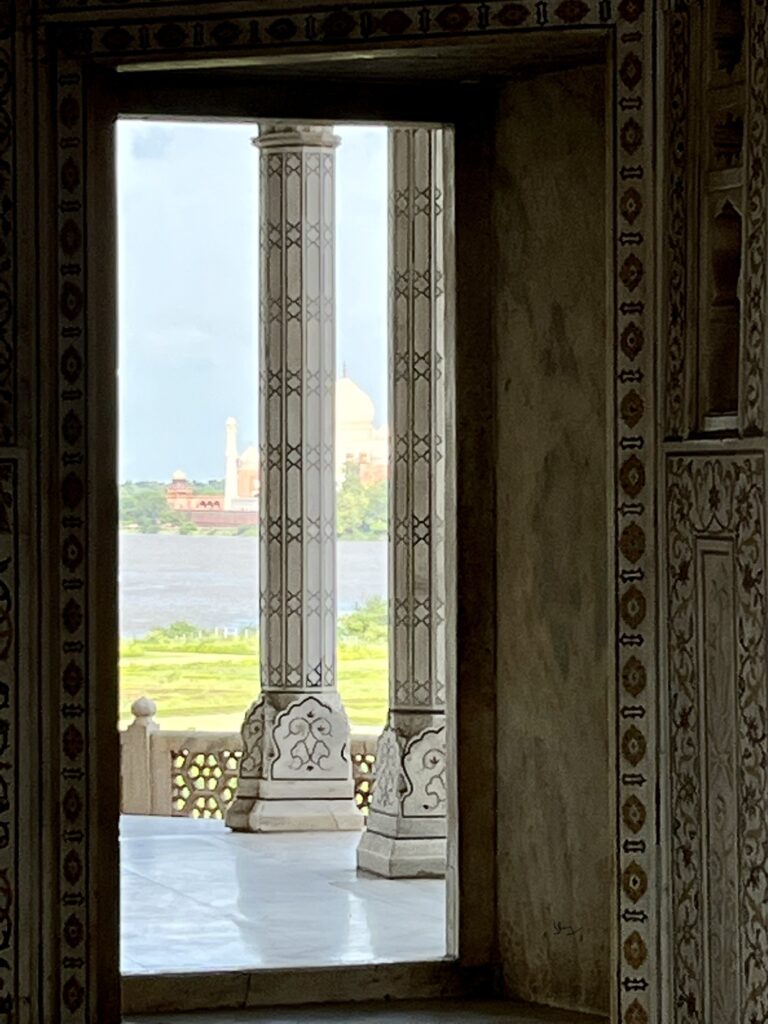
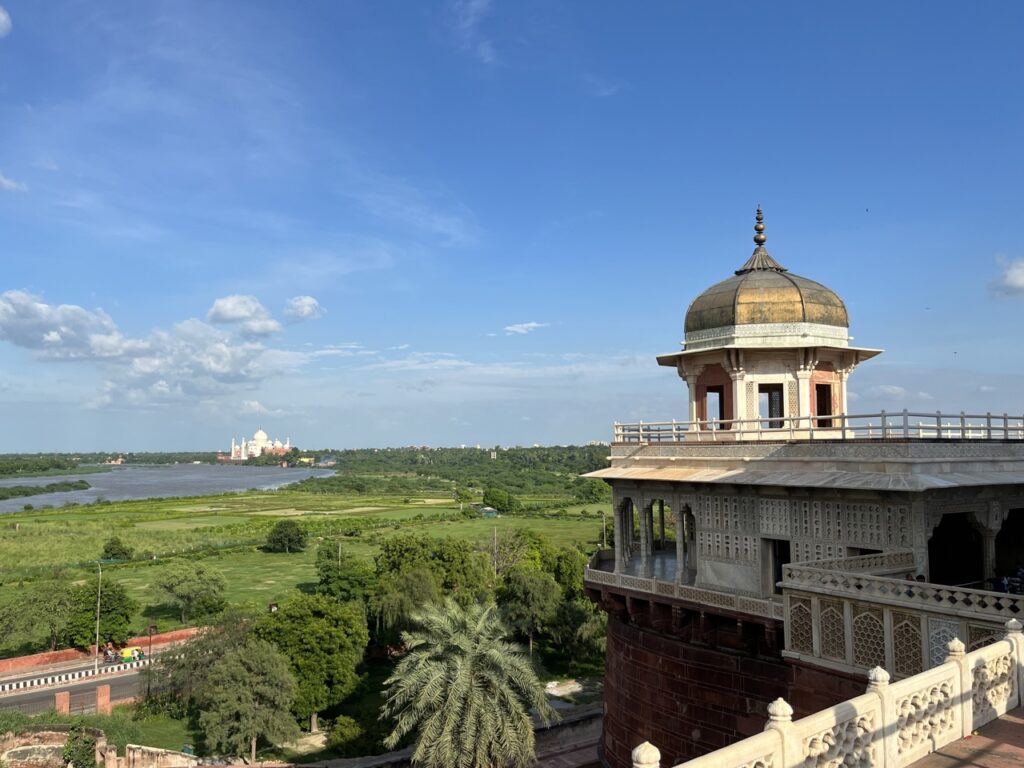
- The Muthamman Burj (Shah-Burj) & Jharokha (1632 -1640 A.D.): This beautiful palace surmounts the largest bastion of Agra Fort on the riverside, facing the East. It was originally built of red stone by Akbar who used it for jharokha darshan, as well as for sun worship, every day at sunrise. Jehangir also used it as jharokha, as is faithfully shown in his painting made in 1620. Owing to its octagonal plan, it was called ‘Muthamman Burj’. It has also been mentioned as ‘Shah-Burj'(the imperial or king’s tower) by Persian historians and foreign travellers. Its name jasmine tower or ‘Samman-Burj’ as recorded by the contemporary historian Lahauri is a misnomer. It was rebuilt with white marble by Shah Jehan around 1632-1640 A.D. This palace is directly connected to the Diwan-i-Khas, Shish Mahal, Khas Mahal, and other palaces. This Burj offers a full and majestic view of the Taj Mahal where Shah Jehan spent eight years (1658-1666 A.D.) of his imprisonment in a complex, and it is said that he died here. His body was taken by boat to the Taj Mahal and buried.
- Sheesh Mahal (A.D. 1631–40): It was built by Mughal Emperor Shahjahan as a part of the summer palace. Its most distinctive feature is glass mosaic work done on its walls and ceiling. These glass pieces have high mirror quality which glittered and twinkled in thousand ways in a semi-dark interior. The glass was imported from Haleb of Syria. Shahjahan built a glass palace in Lahore and Delhi.
Tourists are not allowed inside the Sheesh Mahal and only special state guests and VIPs can ever get a glimpse of its real magic
Jahanara and Roshanara Begum’s Palace: These 2 palaces are located just beside the Shah Jahan’s Palace, made of White marble and resemble a Palanquin in which a bride was taken home after marriage. It is known that both these daughters of Shah Jahan were not married. Jahanara is known to be very close to Shah Jahan and took care of him till his last breath. Roshanara is also known as the First Lady and helped his brother Aurangazeb during his succession.
There are disturbing facts made by certain historians who claim that Shah Jahan married his own daughter after the death of Mumtaz Mahal as resembled her mother and was extremely sensuous. I really do not want to dwell on this even if it’s a fact coz it makes our minds question the integrity of even looking at the Taj Mahal as a symbol of Love!
What I want my readers to however remember here is that these Palaces displays one of the best optical illusion created by the architects of that time. If you walk to the balcony of the Jahanara Palace the Taj Mahal looks pretty small, however, if you walk backwards it starts to get bigger and bigger! You don’t have to believe me, just check it out yourself during your next visit!
The Meena Bazaar: The fact I am presenting now is completely unverified as I have not found mention of it across any of the books or literature that I have read. There is no denying that the place under discussion was a marketplace where goods were sold for the royals and the market used to be conducted on a regular basis. But my guide mentioned that Salim(Jahangir) met Anarkali in the Bazaar here! I doubt but such stories keep the interest to dig more and I will let you know once I unearth documented facts regarding it.
Diwan I Aam-
This large courtyard catches the attention due to the magnificent work on white marble where the Royal family used to sit down to listen to the commoners. Originally there was no stone-and-mortar Divan-i-Am building in this fort and was built later on. The imperial Jharokha (throne) chamber in the middle of the eastern wall is of white marble with intricate ornamentation.
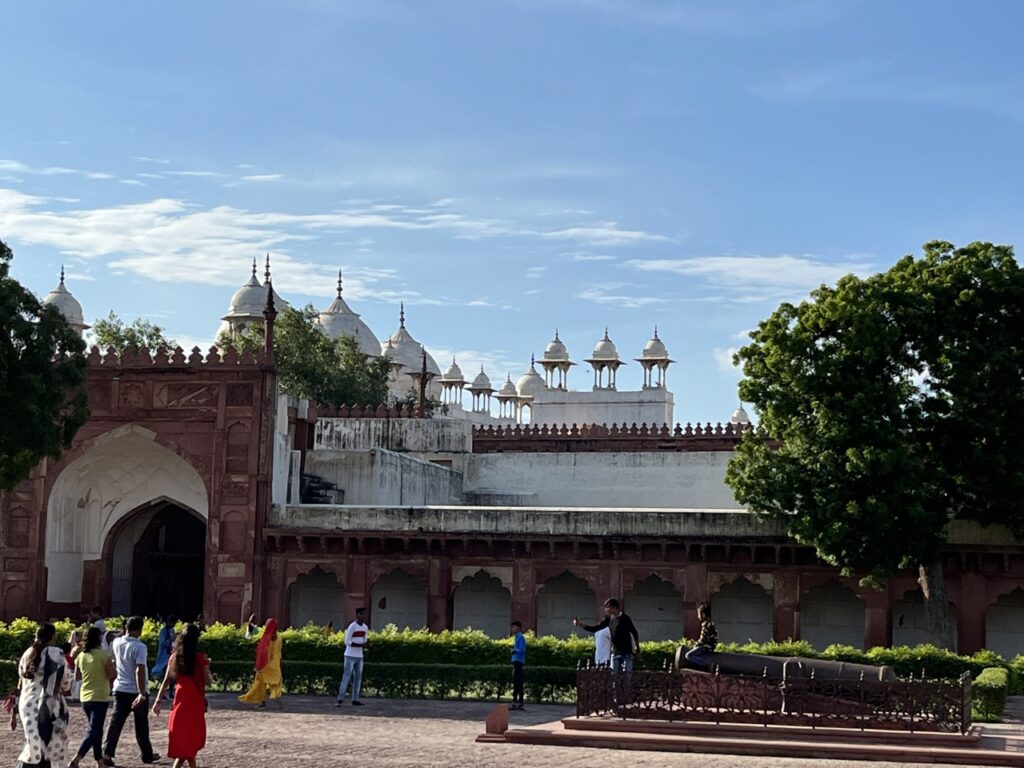
Night visit to the Taj Mahal
I have earlier published a blog in my travel tip section with regards to the night visit to Taj. Complete details in terms of procurement of tickets to the actual experience are mentioned for my viewers and readers, even in this blog on Day 1.
Please go through it in detail to make the best of the night sighting of the Taj Mahal!
Day 3
The Taj Mahal

Key Facts
- The Taj Mahal was built by Shah Jahan in 1631, in memory of his wife Mumtaz Mahal, who passed away on 17 June 1631, during the childbirth of their 14th child.
- The mausoleum took 16 years to be completed
- Timing: 7 AM- 5 PM. It is closed all Fridays. The rule however states Sunrise to Sunset and thus have found entry being provided even at 630AM
- A ticket for an Indian adult ( >15 years) is ₹ 50/- while for Foreign Adults it is ₹1100/- and ₹540/- for SAARC and BIMSTEC countries
- I will always recommend entering through the East Gate if possible as the pathway to the gate is maintained in a world-class manner
- Tickets can be purchased online from the ASI website or at the counter or through DIY using the QR code; Link for online tickets: https://asi.payumoney.com/
- Shoes are not allowed in the Mausoleum nor are there any designated stores to keep the shoes.
- The alternative is to carry a shoe cover that has to be worn before entering the Mausoleum. Ideally, these covers are to be provided free for tourists as the notice board declares however the reality is each of them is sold at ₹40/- per pair.
- The entry and exit points are different thus if a tourist does not procure a shoe cover, they will have to walk a complete circle to come back to their point of entry in naked feet. Imagine doing this on marble in the afternoon. I can guarantee you a few blisters if not more for this heroic. Thus please avoid saving money and jauntily sign up to promote this shoe cover scam
The best time to visit the Taj Mahal is as soon as the entry gates are opened for tourists. This is the time when the climate is favourable and due to the low influx of tourists the ability to get clear shots are at its best. Thus I got up around 6 AM and headed straight to see this 7th Wonder of the World!
In the section on Key Facts, I have mentioned a quintessential requirement to enter the Mausoleum. Please read and follow it to avoid wasting unnecessary time in finding your footwear.
The first view of the Taj Mahal has always made me awe-struck and I have gaped at this magnificent structure with my jaws open. The next thing that catches my attention is the Tomb of the Taj. This large, white marble structure stands on a square plinth and consists of a symmetrical building with an iwan (an arch-shaped doorway) topped by a large dome and finial.
Prince Khurram was born in 1592 and became Shah Jahan, the 4th Mughal Emperor of India. While strolling in Meena Bazaar in 1607, he chanced upon a beautiful Persian noble girl, Arjumand Banu. He was 14 and she was 13 years old and still went ahead to seek Jahangir’s permission to get married. They were married in 1612 and Shah Jahan gave her his Royal seal and the title of Mumtaz Mahal in 1528.
The main finial was originally made of gold but was replaced by a copy made of gilded bronze in the early 19th century. This feature provides a clear example of the integration of traditional Persian and Hindu decorative elements. The finial is topped by a moon, a typical Islamic motif whose horns point heavenward.
The minarets, which are each more than 40 metres (130 ft) tall, display the designer’s penchant for symmetry. They were designed as working minarets— a traditional element of mosques, used by the muezzin to call the Islamic faithful to prayer. Each minaret is effectively divided into three equal parts by two working balconies that ring the tower. At the top of the tower is a final balcony surmounted by a chattri that mirrors the design of those on the tomb. The chattris all share the same decorative elements of a lotus design topped by a gilded finial. The minarets were constructed slightly outside of the plinth so that in the event of collapse, a typical occurrence with many tall constructions of the period, the material from the towers would tend to fall away from the tomb
The Taj Mahal was constructed using materials from all over India and Asia. It is believed over 1,000 elephants were used to transport building materials. It took the efforts of 22,000 labourers, painters, embroidery artists and stonecutters to shape the Taj Mahal. The translucent white marble was brought from Makrana, Rajasthan, the jasper from Punjab, and the jade and crystal from China. The turquoise was from Tibet and the Lapis lazuli from Afghanistan, while the sapphire came from Sri Lanka and the carnelian from Arabia. In all, twenty-eight types of precious and semi-precious stones were inlaid into the white marble
According to the legend, Shah Jahan decreed that anyone could keep the bricks taken from the scaffold, resulting in the dismantling by peasants overnight. A 15-kilometre tamped-earth ramp was built to transport marble and materials to the construction site and teams of twenty or thirty oxen pulled the blocks on specially constructed wagons. An elaborate post-and-beam pulley system was used to raise the blocks into the desired position. Water was drawn from the river by a series an animal-powered rope and bucket mechanisms, into a large storage tank and raised to a large distribution tank.
The plinth and tomb took roughly 12 years to complete. The remaining parts of the complex took an additional 10 years to complete. Since the complex was built in stages, discrepancies exist in completion dates due to differing opinions on “completion”. Construction of the mausoleum itself was essentially completed by 1643 while work on the outlying buildings continued for years. Estimates of the cost of construction vary due to difficulties in estimating costs across time. The total cost at that time is estimated to be about ₹ 32 million, around ₹ 52.8 billion at present.
There is another legend that Shah Jahan planned to build a black marble Taj Mahal across the Yamuna river. This fact is also documented in the writings of Jean-Baptiste Tavernier, a European traveller who visited Agra in 1665. This idea seems to be the reason that Aurangzeb imprisoned Shah Jahan to save the treasury from being emptied. Ruins of blackened marble across the river in the Mehtab Bagh, seemed to support this legend. However, excavations carried out in the 1990s found that they were discoloured white stones that had turned black.
There are widespread claims that Shah Jahan chopped off the thumbs of all the craftsmen and artisans so that they cannot build a similar structure again. This claim has moved by word of mouth for generations and thus on a personal level, I tend to believe it. Although there is no concrete evidence to support this claim!
Walking away from these thoughts I reached the back side of the Taj to spend some time in solitary. The Yamuna flowing by and the Agra fort in the silhouette provided the right contrast for a photographer’s delight. I could see a few photographers on the other bank of the Yamuna taking pictures and wondered how beautiful would it look!
After spending almost an hour and a half I started walking back to my hotel with memories of a lifetime. It was my final destination in Agra on this trip and time to head back to New Delhi. But before that, I deserved a sumptuous breakfast!
I would also recommend my readers to find at least 2 hours and visit the following places of interest in Agra. These structures are equally beautiful and definitely need our attention.
- Itimad-ud-Daulah’s Tomb– Also called the Baby Taj or the mini Taj
- Akbar’s Mausoleum: Excellent garden to find deers and peacocks too. Just beware of monkeys if you are carrying food items.
I hope this article will help you in your endeavour to travel and plan better. You can leave your suggestions if any in the comment section and for tour-related help please feel free to drop an email at journey@indra


